| Author |
 Topic Topic  |
|
ullix
    
Germany
1222 Posts |
 Posted - 08/19/2020 : 07:11:27 Posted - 08/19/2020 : 07:11:27


|
There is an elaborate post on the topic of light-sensitivity of the M4011 tubes done almost 3 years ago: http://www.gqelectronicsllc.com/forum/topic.asp?TOPIC_ID=4540
But the effect is back! And it brings a new surprise.
Back then the M4011 tubes were made of clear glass. As a consequence, GQ modified the tubes by covering them with a black, plastic-like cover. Presumably assuming that the black cover would absorb all light before entering the tube, and therefore the light cannot make problems in the inside of the tube, creating spurious counts.
Sounds reasonable and it seemed to have worked. However, cause and effect is anything but clear, since I have also seen clear glass tubes, which did not exhibit any light-sensitivity whatsoever.
But, surprise, surprise, my tube tested now is one of those blackened tubes, and it does show a pronounced light sensitivity!
My conclusion is that some unknown - at least unknown to us - detail in the manufacturing is causing the problem, and it is just coincidentally related to the blackening. It is a fact now that some of the M4011 tubes are light sensitive, be they clear glass or blackened glass!
So, here are the data as graph, explained below. Anything which rises from the True Background scatter is made by light; needless to say but for completeness: nothing radioactive is anywhere near the tube:
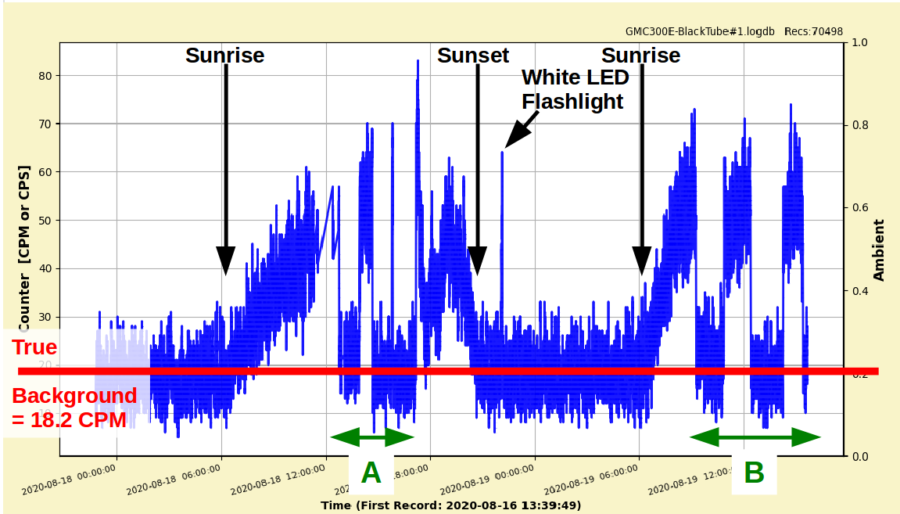
I played with my GMC300E+ counter during preparation for my GeigerLog 1.0 release, and wondered about its high background readings of 50 CPM and more, while I was expecting something under 20 CPM. The counter lay face-down, with its backside removed. So tube and electronics were looking upwards. I measured the anode voltage (by 10MOhm DVM via 1 GigaOhm resistor) as about 380V. This is rather low - I left it unchanged - but concluded that a too-high voltage was not the cause for high readings.
Inadvertently I laid some paper copies over the counter, and then noticed a drop in counts. I removed the copies and saw the counts rise. I repeated a few times and always got the same effect, as shown in the part marked with a green A. Just to the right of the A phase, you can even tell the weather from the counter data, as it changed from bright sunshine to rain and clouds, dimming the sunlight to different degree, but quite noticeable!
During the night, pitch-black outside and in my study, I shone a white LED flashlight on the tube, and it also resulted in increased counts; see marking in the picture.
It still seemed doubtful to me that a blackened tube is light-sensitive, and I suspected that the culprit is actually some other part of the electronic. So, I constructed a cardboard sleeve for the black tube. This would keep only the tube covered, and everything else exposed. The "sleeve device" with tube is shown in the photos, and the counter results are shown in the phase Green B part. Barely readable: the tube is a black M4011 2017 one. Clearly, with the sleeve on, the counts are right into background level.
So, nope, it is not the electronics, it is the tube and nothing but the tube. The blackened tube!
There have recently been quite a few reports about unexpected high count rates. My advice: check for light sensitivity!
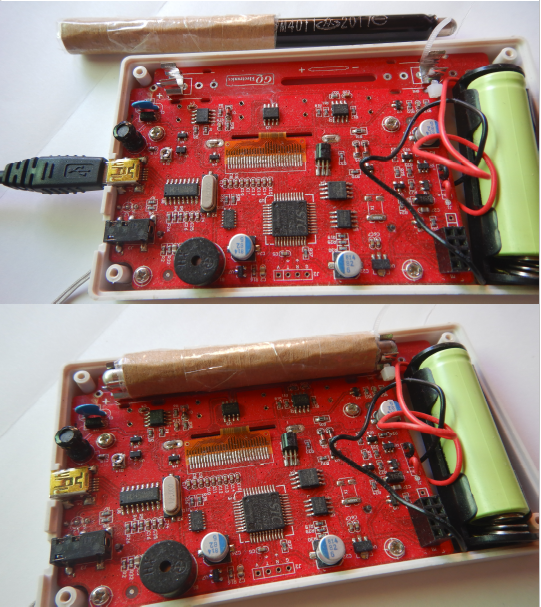
|
|
| Reply #1
ullix
    
Germany
1222 Posts |
 Posted - 08/20/2020 : 00:14:50 Posted - 08/20/2020 : 00:14:50


|
@DAmien: yes, this inner metallization is the cathode. And a short stub of a wire inside connects it to the outer connection. You can see it well in the pictures in Reply #16 and Replay #21 of this old topic http://www.gqelectronicsllc.com/forum/topic.asp?TOPIC_ID=4540
quote:
UV light that we naturally find only in summer.
UV light absent during winter time??? That is surely not the case! I don't know by what degree the UV light is reduced because the sun light needs to travel a longer path through the atmosphere to reach us here in the northern hemisphere during winter time, but absent? No! Go and do some winter vacation in the snow and wear neither sunglasses nor sunscreen!
I also doubt that a lot of UV is coming out of an LED. Perhaps nothing, because most white LEDs use a blue LED, not UV. I don't know, what my flashlight has. But even if it were UV, the epoxy lens case containment of the LED is an absorber for UV. The degree, however, I do not know.
Plain window glass is also a good absorber for UV. Try to get a sunburn behind a window - it is really difficult. And obviously, my counter is inside my study behind windows.
But the UV surely is not alone in creating spurious Geiger counts. I also tried shining a Halogen lamp on the tube, and the counts also increased. Unfortunately, while incandescent produce basically no UV, they produce a lot of infrared. I did not show these results, because the heating effect of such light could have an effect on the electronics, confounding the results.
I am reproducing here a picture from that old topic 4540, showing the comparison of two clear glass tubes. These are also my own measurements. One tube is light sensitive, the other is not:
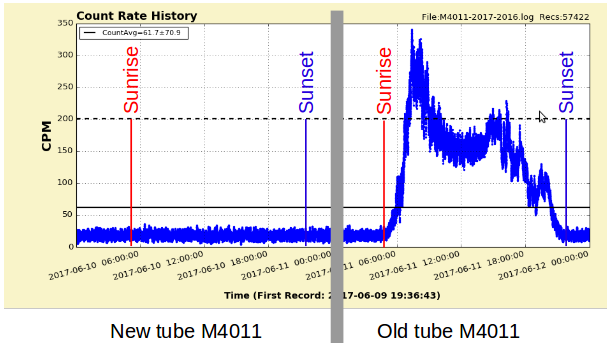
It proves that you can produce glass tubes - be they clear glass or painted glass - which are not light sensitive, but then some of them are, be they clear or painted glass.
What is causing it? Is it some minute variation in the manufacturing process? And can one see it at a freshly manufactured tube, or only after some aging has taken place?
One thing seems obvious: you will find GMC counters, which are counting light!
|
 |
|
| Reply #2
Damien68
    
France
780 Posts |
 Posted - 08/20/2020 : 03:43:56 Posted - 08/20/2020 : 03:43:56


|
@ullix,
you are right, white leds have a blue light emitter at least for certain white led, and necessarily for all that are supplied with 3v (Max photon energy can't be sup to 3eV (415nm)).
Looking at your post I found the photo below:
I do not know if it is a perspective effect but on the tube sensitive to light, it gives the impression that the contact of the cathode goes up a little and approaches the anode, is this the case?

The anode rod is also slightly shifted but that should not play as long as it remains blocked in its glass insulator. But this is not a sign of quality.
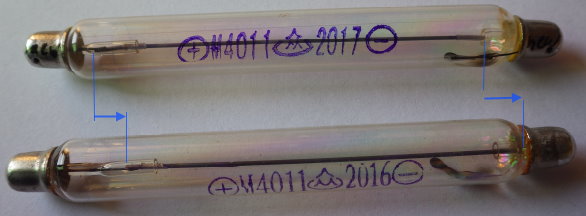
|
Mastery is acquired by studying, with it everything becomes simple |
Edited by - Damien68 on 08/20/2020 04:30:42 |
 |
|
| Reply #3
ullix
    
Germany
1222 Posts |
 Posted - 08/20/2020 : 05:59:16 Posted - 08/20/2020 : 05:59:16


|
@Damien: (did you delete your initial post yourself, or is someone else deleting?)
If your observations are relevant, you will surely get the Eagle-Eye-Award ;-) but in the moment I doubt that it matters. But I don't know.
Unfortunately, I have misplaced that specific tube :-(, and can't answer this question.
These inner wires seem to be flattened at the point of contact with the inner glass wall, a bit like a fly flattened to the window with a flyswatter. Then, when you look at it from the outside, depending on your view angle, it may look as if it extends toward the anode wire. If it did it might indeed result in a localized higher electric field, and perhaps spurious counts.
"Not a sign of quality" - I'm surprised these things can be build at all - no idea how this is done - but perhaps these shifts are perfectly ok. If GQ could publish something about the manufacturing process of the tubes, I am very interested.
But there certainly should not be light-sensitivity.
|
 |
|
| Reply #4
ullix
    
Germany
1222 Posts |
 Posted - 08/20/2020 : 06:41:56 Posted - 08/20/2020 : 06:41:56


|
User theMike suggested this experiment, and the outcome is interesting.
"Repeat the GMC300E+ experiment by putting the black tube into the GMC500+ counter. This will rule out that it is merely the 300's electronic or some other 300 property running havoc on the counts."
The 500+ counter is the one thoroughly discussed here http://www.gqelectronicsllc.com/forum/topic.asp?TOPIC_ID=5369 and it is the one where this specific black tube has come from.
Experiment almost the same: counter lays face down on my desk with backside removed. The tube, however, this time is not wrapped in a sleeve, instead I simply use a large piece of light-tight cardboard to generously cover the whole counter. This allows to change from no-light to light condition without shutting down the counter and the GeigerLog recording. This is the outcome:
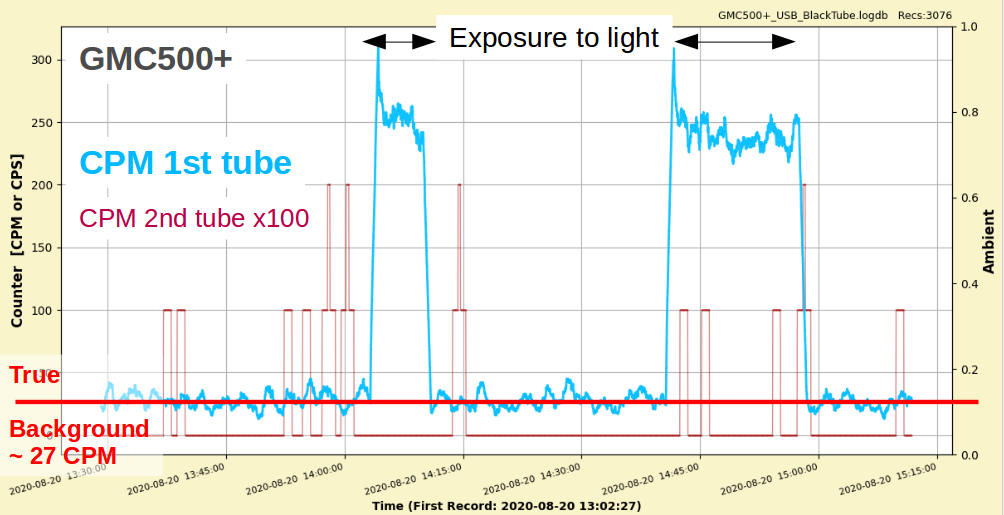
The 500+ counter can record CPM and CPS of tube#1 and tube#2, (as well as CPM/CPS of the sum of both, which is nonsense). GeigerLog can record all 6 of those. The graph shows the individual CPM for tube#1 and tube#2. Tube#2 counts are multiplied by 100 to make these few counts visible.
Again, very clearly, the black tube, i.e. tube#1, comes out as light sensitive. Acoustically you hear a burst of ticks upon removing the cardboard cover and exposing the tube to light.
The tube#2 is not responding to the light. But since it is so insensitive anyway, this is not really surprising.
What is very interesting, however, is the fact that this tube in the 500 gives higher counts than in the 300: background is 27 vs 18, and light-counts are 250 vs 60. It seems that the electronics, which discriminate between count and non-count is set to higher sensitivity in the 500+ counter. Makes you wonder why the two use the same "calibration"?
Again confirmed: it is the tube, not the counter giving spurious counts!
|
 |
|
| Reply #5
Damien68
    
France
780 Posts |
 Posted - 08/20/2020 : 10:05:16 Posted - 08/20/2020 : 10:05:16


|
It's me who pulled my post off because the UV I talked about finally seemed to me irrelevant. it's not very smart to do that :-)
The connection wire inside the tube for the cathode is certainly crushed to enlarge the contact surface between the wire and the metalization of the tube and can be at the same time for glued it.
Even well placed against the glass of the tube, this wire should reduce the air gap between the anode and the cathode, and as you say induce a critical area where the electric field becomes more larger, then changing physical conditions. If in addition the pad is unstuck, let's not talk about that.
Normally the count should be the same with a GMC-300 and a GMC-500 as long as they have the same tube.
There may be differences between the two meters in terms of detection, but it can also come from stability and setting of the 400v HV generator. I don't know how the GMC-300 HV generator is made but on the 500+ I say that it is very optimized for the cost, which is a choice that I respect and is not bad but with other factors can pose problems.
there is surely a conjunction of several factors which causes this defect, this is why it is not easy to identify clearly, but the first culprit is certainly the tube anyway.
The M4011 is a china made but I don't believe that this is a production specific to GQ or maybe yes. |
Mastery is acquired by studying, with it everything becomes simple |
Edited by - Damien68 on 08/20/2020 22:45:56 |
 |
|
| Reply #6
Damien68
    
France
780 Posts |
 Posted - 08/22/2020 : 23:06:26 Posted - 08/22/2020 : 23:06:26


|
@ullix,
looking to your post again, i find this photo which shows that the cathode wire is simply rolled on the tube.

It would therefore only be an effect of perspective.
between the 2016 and 2017 version, there is also the size of the main anode insulator which changes, it has to be shortened on 2017 certainly to increase the effective volume detection
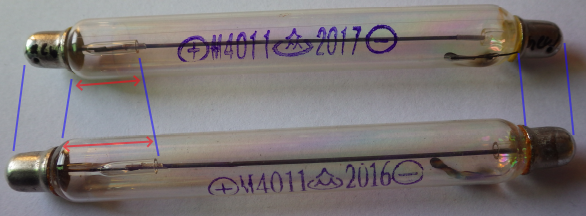
the two different that I noted are certainly due to the evolution of the product, there may have been other (gas composition, pressure ...)
SO: Back to square one
|
Mastery is acquired by studying, with it everything becomes simple |
Edited by - Damien68 on 08/22/2020 23:26:57 |
 |
|
| Reply #7
ullix
    
Germany
1222 Posts |
 Posted - 08/22/2020 : 23:31:58 Posted - 08/22/2020 : 23:31:58


|
It could all play a role, I just don't see that we can base a conclusion on just 2 samples of tubes. We'd need like 100 and see whether your observations materialize. I don't see that we can handle that?
|
 |
|
| Reply #8
Damien68
    
France
780 Posts |
 Posted - 08/23/2020 : 00:45:44 Posted - 08/23/2020 : 00:45:44


|
that's for sure, with two sample we can't be formal.
I have already worked with China, there are some good things and others not so good, I think even GQ might have difficulty to be formal because the problem with China is that unless you have established precise specifications, you always buy a product as it is, they can change things without warning, and even stop production without notice ...
for M4011 tubes, I can't find who the manufacturer is, and if we have difficulty finding precise specifications, there is certainly a reason, in my opinion they do not exist yet, so product is open to any change. |
Mastery is acquired by studying, with it everything becomes simple |
Edited by - Damien68 on 08/23/2020 00:51:44 |
 |
|
| Reply #9
ullix
    
Germany
1222 Posts |
 Posted - 08/23/2020 : 00:50:05 Posted - 08/23/2020 : 00:50:05


|
With still a bit of lingering doubt that the counter itself could be responsible for the light sensitivity, and not the tube, I tried the black tube with yet another counter.
It's called "Radiation-v1.1 (CAJOE)". It is a low-cost device with limited features, for enthusiasts a device complementing a GMC counter. It is only capable of generating the High-Voltage, and creating audio pulses for a count event. The rest does GeigerLog, which, using its own audio-driver, analyzes the audio signal and extracts the pulses. I just published a report on the use of this device with GeigerLog: https://sourceforge.net/projects/geigerlog/files/Articles/GeigerLog-Radiation-v1.1%28CAJOE%29-Support-v1.0.pdf/download .
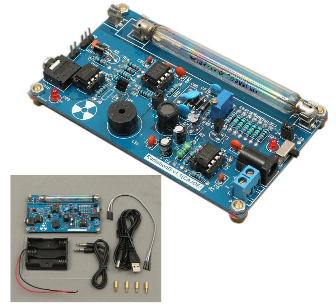
As with the GMC counters with their backside removed, the tube here is fully exposed. I measured background with either the tube uncovered (light) or covered with a light-tight piece of cardboard (dark).
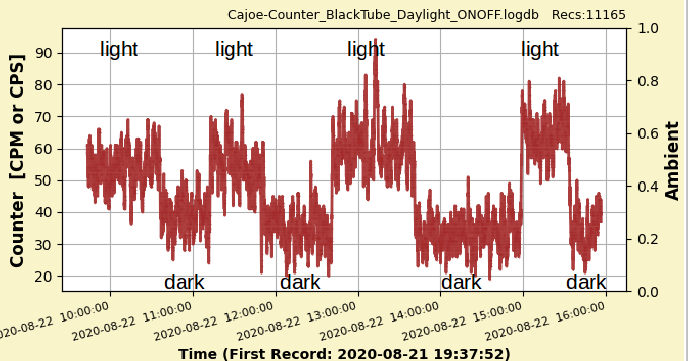
The right half are the more midday times with a bit more sunshine.
Same result as before: the black tube is light sensitive.
|
 |
|
| Reply #10
Damien68
    
France
780 Posts |
 Posted - 08/23/2020 : 00:54:35 Posted - 08/23/2020 : 00:54:35


|
if by wrapping it with a piece of paper, there is no light sensitive, this proves that it is the tube.
the black tube is therefore not as black as its name ;-)
and at the same time they had to change the gas or something to make it less sensitive to light
|
Mastery is acquired by studying, with it everything becomes simple |
Edited by - Damien68 on 08/23/2020 01:12:58 |
 |
|
| Reply #11
ullix
    
Germany
1222 Posts |
 Posted - 08/23/2020 : 01:05:20 Posted - 08/23/2020 : 01:05:20


|
quote:
the black tube is therefore not as black as its name ;-)
Yeah, I see a dark future for the black tube ... |
 |
|
| Reply #12
Damien68
    
France
780 Posts |
 Posted - 08/23/2020 : 01:23:48 Posted - 08/23/2020 : 01:23:48


|
yes let's say it's sad to see people who have problems with this, there are several on the site, but at the same time the idea of wrapping a piece of paper around the tube seems good to me and can be a solution for those who have a light sensitive tube.
After that it's important to be careful because the paper can retain humidity, so is better to avoid that the paper comes too close to the anode contact. |
Mastery is acquired by studying, with it everything becomes simple |
 |
|
| Reply #13
ullix
    
Germany
1222 Posts |
 Posted - 08/23/2020 : 01:41:17 Posted - 08/23/2020 : 01:41:17


|
Easier than paper might actually be plastic, like heat-shrink tubing. You may not even have to shrink it. But does it have side effects? I'll try.
But, whatever you wrap, there goes the beta sensitivity ... |
 |
|
| Reply #14
Damien68
    
France
780 Posts |
 Posted - 08/23/2020 : 02:06:52 Posted - 08/23/2020 : 02:06:52


|
there may be moisture between the plastic and the glass and may be a bit porous, so this may cause small leaks, so it is still best to avoid contact with the anode.
Otherwise there may also be the solution to wrap just one turn with a sheet of household aluminum foil, this is what is most opaque to light, but it may also block the gamma. it's a bit on the idea of what the Russians are doing with the SBM-20, but they're not aluminum, so I don't really know what it can be make |
Mastery is acquired by studying, with it everything becomes simple |
 |
|
| Reply #15
ullix
    
Germany
1222 Posts |
 Posted - 08/23/2020 : 02:45:16 Posted - 08/23/2020 : 02:45:16


|
Well, if your concerns are valid then the choice of paint for the black cover may not have been so bad after all? Except that it did not help.
The SBM20 has a stainless steel wall of 50mikrometer.
Household aluminum foil has a thickness of 20mikrometer (or less). The half-value thickness for 100keV gammas is 15.2 mm (https://de.wikipedia.org/wiki/Halbwertsschicht ) so the attenuation of 20mikrometer is 0.99908. That is irrelevant for us. It will be more pronounced for betas, but - look at the SBM20 with 50mikrometer steel which is doing quite well for betas - is acceptable. My guess is the glass thickness is a more relevant absorber.
But what about these mylar-windowed tubes. Are they all light sensitive? I don't think so.
So, what makes some glass tubes light sensitive, while other glass tubes are not?
|
Edited by - ullix on 08/23/2020 02:46:37 |
 |
|
| Reply #16
Damien68
    
France
780 Posts |
 Posted - 08/23/2020 : 03:03:15 Posted - 08/23/2020 : 03:03:15


|
Why are they sensitive to light? I ask myself the same question. It's quantum mechanics, I saw that in fundamental physics class in faculty but it's been a long time.
I have seen on some posts there are people who say that normally it should not be sensitive to light. why the light triggers an avalanche in the tube (this is what we detect), I do not know exactly but in any case it is mainly linked to the nature of the gas composition which is in the tube, to its pressure, and to the electric field present.
I imagine but it is only a speculation that there were changes made by the manufacturer in gaz composition or pressure.
there is not much difference between the nature of a photon and a gamma except that the gamma is enormously more energetic.
therefore the sensitivity to light would be in some way due to an exasperated sensitivity caused by the nature of the gas or something else. |
Mastery is acquired by studying, with it everything becomes simple |
Edited by - Damien68 on 08/23/2020 03:42:35 |
 |
|
| Reply #17
ullix
    
Germany
1222 Posts |
 Posted - 08/23/2020 : 05:26:09 Posted - 08/23/2020 : 05:26:09


|
Don't forget that we have been through this discussion before in this topic:
http://www.gqelectronicsllc.com/forum/topic.asp?TOPIC_ID=4540
Ruled out: gas activation by UV light (not enough energy per quanta) see Reply#4
Possible: Photoelectric effect. (Einstein's only Nobel Prize) see Reply#6
But if it is the latter, why only some tubes and not all? It is physics; it applies to all tubes!
|
 |
|
| Reply #18
ullix
    
Germany
1222 Posts |
 Posted - 08/23/2020 : 05:40:53 Posted - 08/23/2020 : 05:40:53


|
Another little surprise (same setup as in Reply#9, using the Cajoe-Counter).
The aluminum foil wrapping seemed to be the best suggestion. So I wrapped the black tube with our 13mikrometer (perfectly light-tight)Aluminum foil:
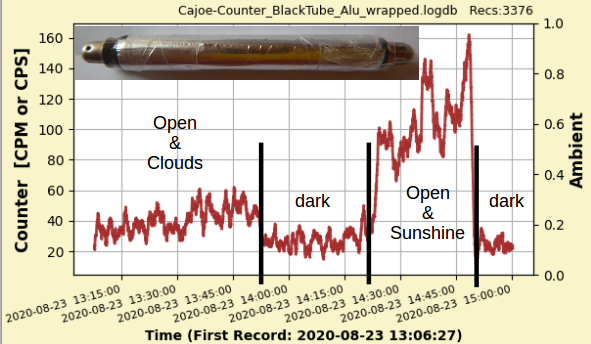
Not quite, but almost, as bad as without anything!
Look closely and you see a little sliver of black glass at the ends. Well, you can't put the alu metal over anode and cathode but need to keep some distance. Should that be enough to make the light-sensitivity effect? Very strange.
|
 |
|
| Reply #19
Damien68
    
France
780 Posts |
 Posted - 08/23/2020 : 06:11:52 Posted - 08/23/2020 : 06:11:52


|
go from 30 to 120 CPM, there is necessarily something.
if you still have the tube with aluminum, you can try to place black adhesive tape on the 2 ends (adhesive for electrician or other). but as it is started, it may not change much.
I don't think that's the cause at all but there is also a precaution to take, to not approach the hand or a metal object too close to the tube, otherwise a capacitive coupling will occur between the cathode of the tube and the external environement which risks inducing interference.
Indeed, to measure the current which passes through the tube, in fact there is a small resistance between the cathode and the mass of the meter, and we measures the voltage at its terminals.
if we get too close to the cathode, we can add noise to this mesurement, a bit like the noise we hear when we approach or touch an input jack of an audio amplifier. |
Mastery is acquired by studying, with it everything becomes simple |
Edited by - Damien68 on 08/23/2020 09:16:21 |
 |
|
| Reply #20
Damien68
    
France
780 Posts |
|
| Reply #21
Damien68
    
France
780 Posts |
 Posted - 08/24/2020 : 23:41:55 Posted - 08/24/2020 : 23:41:55


|
While looking for pictures of the tube on the net, we still find new shapes for the cathode connector:
The two photos are aparently from the same sale lot and both marked 2020 but the shape of the pad seems different (subject to interpretation).

Source: https://www.aliexpress.com/i/4000176769477.html
I have the impression that they sought to increase not the surface but the perimeter of the interface between the anode connection and the metalization of the tube.
This certainly because of an electromigration type effect that can cause micro cuts in the metalization which is really very fine, and can shorten the life time of the tube.
moreover we now find specifications specifying a lifespan of 10e9 count, it remains lower than the standard 10e10
but we are only talking about visible differences. I imagine that the nature of the gas mixture may have changed as well. and it is more a change in the nature of the gas which could explain that some tubes are sensitive to light and others not
But all this is only speculative
|
Mastery is acquired by studying, with it everything becomes simple |
Edited by - Damien68 on 08/25/2020 03:26:32 |
 |
|
| Reply #22
ullix
    
Germany
1222 Posts |
 Posted - 08/25/2020 : 06:34:23 Posted - 08/25/2020 : 06:34:23


|
I think I made a little bit of progress!
Using again the Cajoe-Counter - on the expectation that its simple design gives the least chance for any confounding effect - hooked to GeigerLog via its audio driver, and the black tube put in the holders, I put a mask on the black tube to have only 3 segments of the tube exposed to the light.
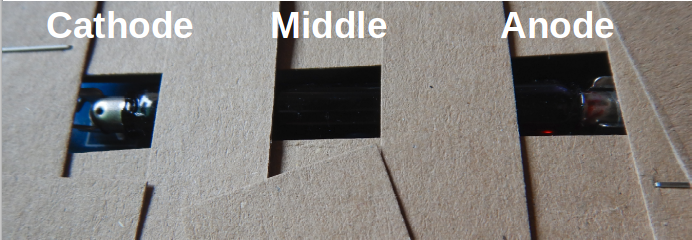
This is simple cardboard, and you notice how little of the tube is exposed by each opening. For the "dark" measurement periods all openings are shut with cardboard. For the measurements one section at a time is opened, always followed by a dark measurement. No radioactive source nearby, this is true background (in the dark) or plus the effect of ambient daylight.
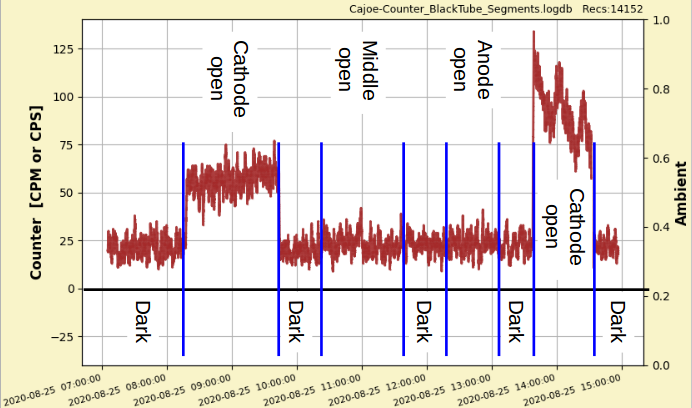
It couldn't be any more obvious: there is only one segment of the tube which is sensitive to light, and this is the cathode! Not a pip of a count for middle or anode!
The different amplitudes of the first and last cathode data is simply the weather: dark clouds in the morning, in the afternoon a mix of sunshine, clouds, and rain (yes, within that short period!).
So, the cathode. Who knows, at the end of the day, Damien gets a job as tube inspector with GQ ;-). But wait, this is a blackened tube! Will be fun to watch him inspect the black tubes ...
The Zero-Effect in the middle is actually helpful. Because it demonstrates that whatever effect happens, it is NOT the activation of gas molecules. Not that you have a chance, because the potential gases in the tube (see Reply#4 here: http://www.gqelectronicsllc.com/forum/topic.asp?TOPIC_ID=4540) have activation energies of 10eV and higher, while visible light has 2...3eV, and even hard UV-B light has less than 5eV. This activation is a quantum process. No chance light can ionize any gas!
What remains is the photo-effect (for which Einstein got his only Nobel Prize); this is possible with even the low energies of visible light. I wouldn't doubt this explanation if every tube showed this effect, but why only some of them? And the blackening does not seem to matter, as I have a tube, which is CLEAR glass, and so far I have been unable to show any light effect with that tube.
And given that it seems to be impossible for light to get through the black paint, does the light even get through? Or is it any strange effect creeping in from the outside? Is perhaps the outside cap of the cathode photoelectrically active and results in all3 tested counters to produce a count?
What on earth makes the cathode - or to be more careful: the cathode end of the tube - behave this way?
|
 |
|
| Reply #23
Damien68
    
France
780 Posts |
 Posted - 08/25/2020 : 10:07:52 Posted - 08/25/2020 : 10:07:52


|
Good job Ullix, we make a good team, we can both go and work in Seattle ;=)
but I tell right away I have long hair and looks like Iggy Pop and I love bass guitar. this is my Curriculum vitae ;=)
The black on the glass is paint, maybe the light pass over the edge of the tube? or the paint is not so opaque?
I find a nice article about photoelectric effect,
https://en.wikipedia.org/wiki/Photoelectric_effect
for it to occur, the photons must have at least the binding energy of the electron to its nucleus.
It is not at all clear to me, I do not yet master this, but we should see the metals used to form the PAD of the cathode, and also the materials used to glue it (we see a kind of glue or glass I'm not sure but it could be conductive glue with metal compounds). but perhaps there could be photoelectric effects on these places:

But it is also possible that the manufacturer was a little naive and to boost the sensitivity of the tube added gas atoms of a more sensitive nature and so sensitive to light.
But in this case there would be no critical area specifically around the anode connection.
to invalidate the second assumption it would be necessary to carry out tests with a slightly lower anode voltage (ex 380v). because the sensitivity of this critical zone could also be due to the low narrowing of the anode-cathode distance
Note: on 2020 version of tube, there is no glue to fix cathod pad
|
Mastery is acquired by studying, with it everything becomes simple |
Edited by - Damien68 on 08/25/2020 10:58:09 |
 |
|
| Reply #24
Damien68
    
France
780 Posts |
 Posted - 08/25/2020 : 11:21:26 Posted - 08/25/2020 : 11:21:26


|
another possibility:
there is an opening on each of the two connectors at each end of the tube. maybe the light can enter through this place.

|
Mastery is acquired by studying, with it everything becomes simple |
Edited by - Damien68 on 08/25/2020 11:35:39 |
 |
|
| Reply #25
Damien68
    
France
780 Posts |
 Posted - 08/26/2020 : 00:58:35 Posted - 08/26/2020 : 00:58:35


|
Incredible!
I still have to find something else,
I scratched the paint off the M4011 Black of my 500+ (you must not do the same thing as me because the paint goes into dust and can be toxic, you have to protect everything to do this and collect all the dust).
even without the black paint and with a lamp pointed at it it's not more sensitive to light, but that we already knew that's not what is incredible.
The assembly is still another time different look at the photos, Anode connection is a simple straight pin with aparently electrolytique deposit. indeed, as Ullix said, it is not with two tubes that we can have a reliable analysis. Indeed with each new tube, we see that it's different, it's hard to think the M4011 could be a mature product, but they certainly know how to solve the photosensitivity problem.
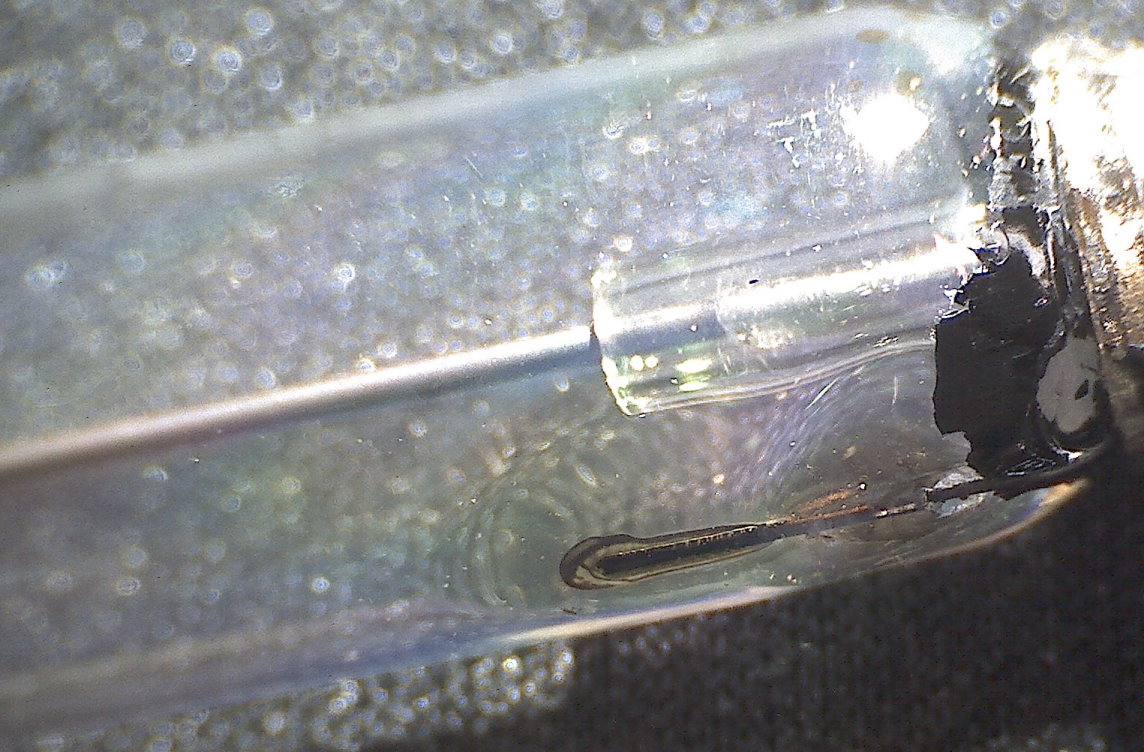
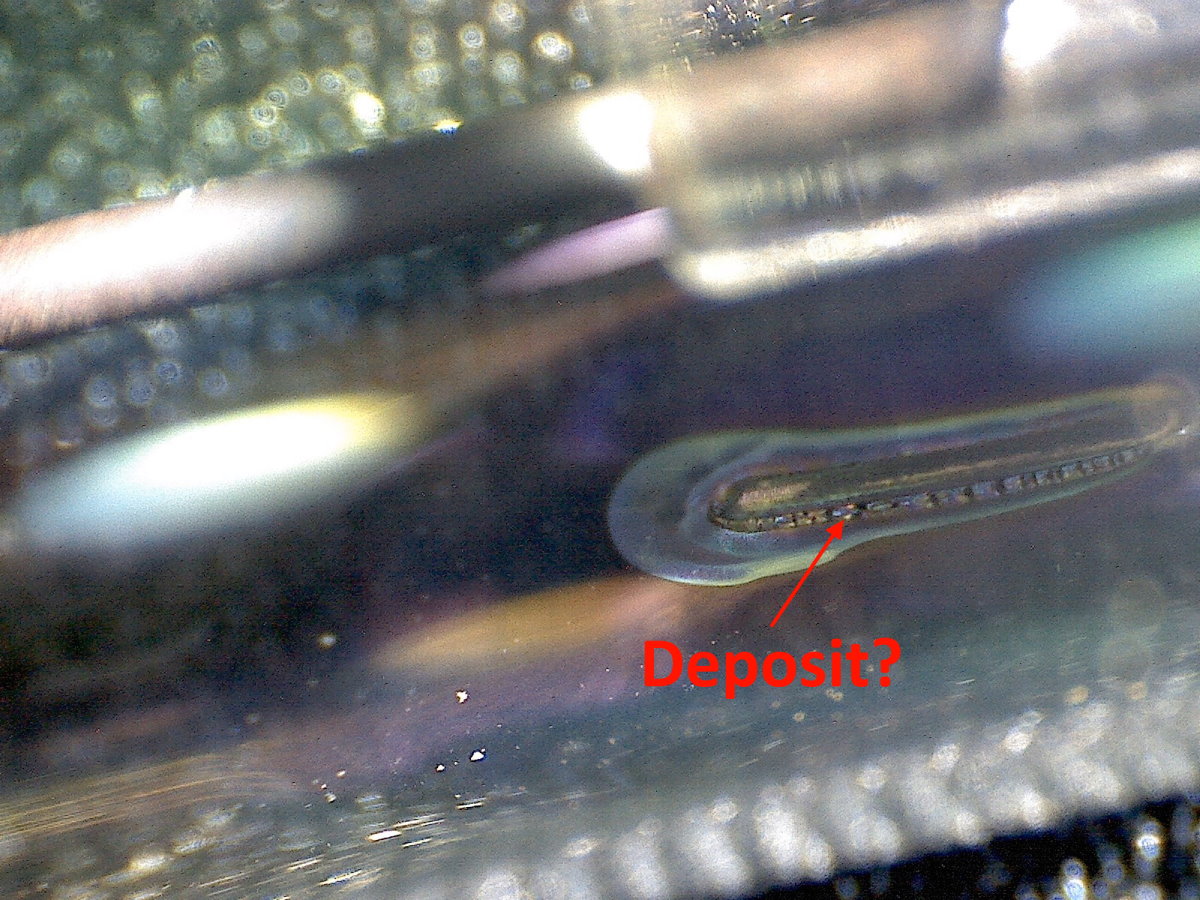
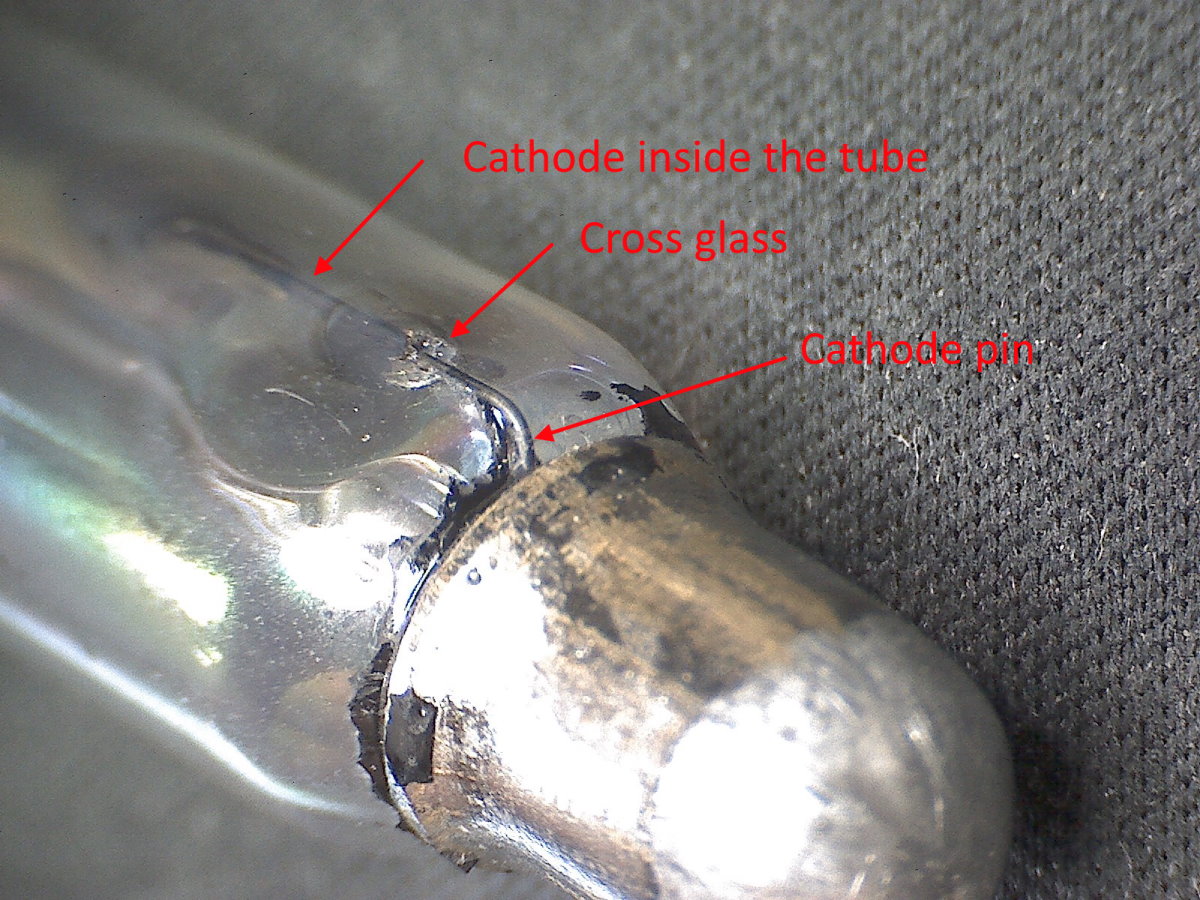
we can easily recognize this type of tube manufacturing even without removing the black paint because we can detect the cathode pin on its external part (with a magnifying glass, we should guess a small ergo under the paint)
|
Mastery is acquired by studying, with it everything becomes simple |
Edited by - Damien68 on 08/26/2020 06:57:08 |
 |
|
| Reply #26
ullix
    
Germany
1222 Posts |
 Posted - 08/27/2020 : 01:28:24 Posted - 08/27/2020 : 01:28:24


|
I guess the best M4011 pictures of the net can now be found in this forum. I was thinking about publishing a Geiger tube magazine: "The Tube". Every issue would have a M4011 picture in the centerfold :-). OMG, I heard Corona does weird things to people.
Damien, I actually do not share your poor opinion on the craftsmanship of the tubes. I think it is a difficult process, which either only very skilled people can do, or well programmed robots. And at the end: if "poor" tubes perform perfectly well, how can one call them "poor"?
I never realized the cathode wire is poked through the glass already before the capped end; I thought they went inside and exited axially. Thanks for the pic, now that I know it, I can easily see and even feel this little piece of wire.
Looking at your first pic in Reply#25 I see two areas of distortion in the glass, as marked in this cutout:
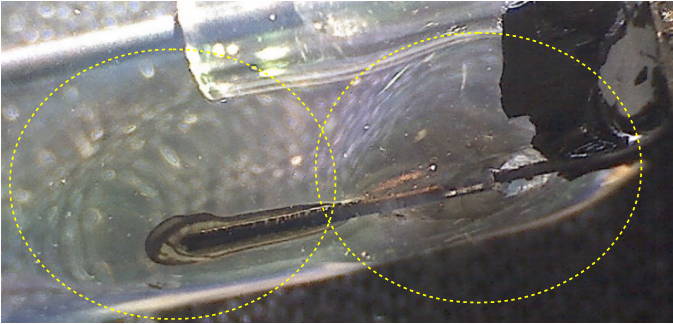
The right one surely is from heating the glass to allow poking the wire through and sealing it into the glass. The left one probably results from melting the end of the wire into the glass from the inside. Perhaps this step is combined with the evaporation of the metal inside the tube, which forms the cathode. The variation in the splotches around this end of the wire may support this view. Deposits? Oh hell, melting and mixing glass and metal may give strange results. And again, it does not seem to hinder the tube in performing well.
But as you have noticed - and I can confirm looking at my tubes - whatever this splotch looks like, it does not seem relevant neither for good nor for bad performance.
I have now got a flashlight with a strong 365nm LED. That is pretty hard UV_B; it is not healthy to look into that UV-B beam! Still, the quantum energy of 365nm photons is only 3.4eV! Just for perspective: the wave length of the 1.46MeV gammas of Potassium-40 is 0.0008nm, some 500000 fold difference.
I tortured my two "good" clear-glass M4011 with it, but they wouldn't budge. Not a bit. No light sensitivity to even UV-B!
Yet my black M4011 responds even to incandescent light. Why?
I now have had only a handful of M4011 and 20% of them are light sensitive. At 20% I cannot imagine that I am the one and only person in the world to receive the only bad tubes ever existing! There must be a whole lot more of bad tubes out at the customers, and they are happily measuring light and call it radioactivity.
|
 |
|
| Reply #27
Damien68
    
France
780 Posts |
 Posted - 08/27/2020 : 03:12:53 Posted - 08/27/2020 : 03:12:53


|
you are right, I have just looked at the tube more closely, is slightly dented / sinked where it was crossed, it has been heated.
I don't believe that all M4011 tubes are make like that, for the transparent tubes I think that the pin comes from the axis of the tube.
The tube is good, but have to get to know him before starring. ;=) |
Mastery is acquired by studying, with it everything becomes simple |
Edited by - Damien68 on 08/27/2020 09:02:23 |
 |
|
| Reply #28
Damien68
    
France
780 Posts |
 Posted - 08/27/2020 : 09:59:34 Posted - 08/27/2020 : 09:59:34


|
@ullix 365nm is nice, I have one that I buyed for coating inspection (coating with colorant) but is 395-410nm, juste the limit of UV :(
Why M4011 responds even to incandescent light? To find out, GQ could sign an NDA with the Chinese and ask them, but after they couldn't tell us, so once again that would be booby. |
Mastery is acquired by studying, with it everything becomes simple |
Edited by - Damien68 on 08/27/2020 10:00:50 |
 |
|
| Reply #29
Damien68
    
France
780 Posts |
|
| Reply #30
Damien68
    
France
780 Posts |
|
| Reply #31
ullix
    
Germany
1222 Posts |
 Posted - 08/30/2020 : 03:55:04 Posted - 08/30/2020 : 03:55:04


|
In further investigating the black tube, I noticed that the strength of the light effect depends on the rotational position of the tube. Upon closer inspection of the tube I saw a bit of damage of the black paint at the cathode end.
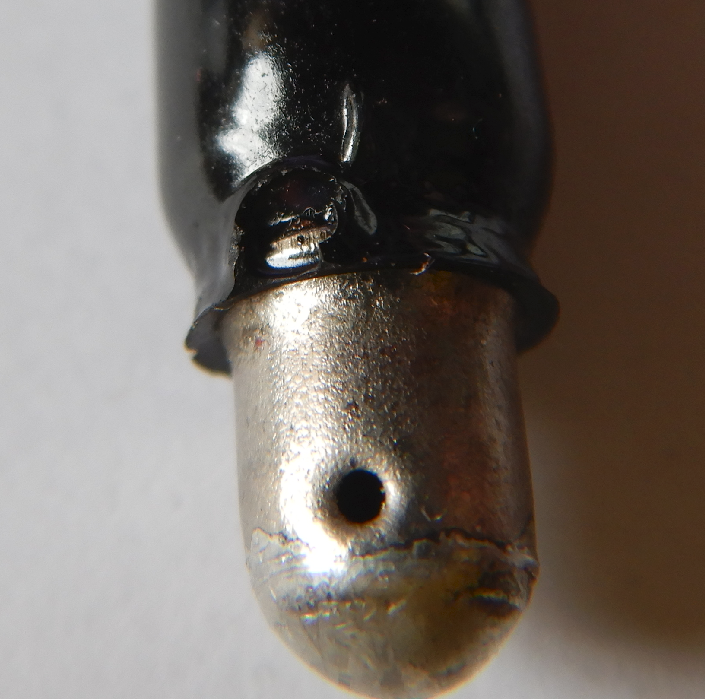
It looks like the paint had initially formed a bubble, which eventually had burst. I do not know whether this damage had been there since I received the tube two years ago, or happened at any later time. But this damage seems to be the only source for the light sensitivity. Directing a white flashlight onto it makes the counts take off like a rocket. Same effect when using UV light (365nm, 390nm). Looking for a more focused light spot to only cover the damaged spot, I used a green laser pointer. The counts also took off, but perhaps not quite as intense. Then I tried a red laser pointer, and all remained quiet. No counts whatsoever (except for the usual CPM=20 background).
A classic Photo-Electric-Effect! Too bad the Nobel prize is already taken ;-)
I searched for a list of activation energies for elements, called Photoelectric Work Functions. I found these sources in big physics text books down to Wikipedia: h**p://web.pdx.edu/~pmoeck/books/Tipler_Llewellyn.pdf https://public.wsu.edu/~pchemlab/documents/Work-functionvalues.pdf h**p://hyperphysics.phy-astr.gsu.edu/hbase/Tables/photoelec.html#c1 https://en.wikipedia.org/wiki/Work_function. The data are close, but not identical. I plotted them by energy, and added colored lines for the energies of my light sources.
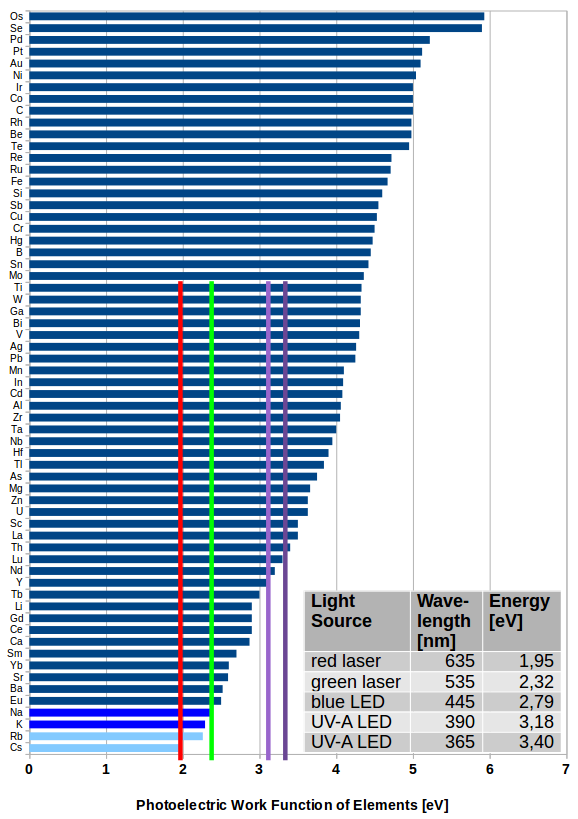
For the vast majority of chemical elements, even 365nm cannot kick out electrons. The red laser has an energy of 1.95eV, and the only thing it might activate is Cesium. Cs has a work function of 1.95eV in one source, but 2.1eV in another. So, while a red laser did not produce counts, it remains unclear whether it can't activate Cs, or Cs is not present.
A green laser can certainly activate Cs, Rubidium, Potassium. Sodium is another borderline case with a laser energy of 2.32eV, and a work function of 2.28eV in one, and 2.36eV in another source.
Of the elements activatable by 390 and 365nm most are rather unusual, with the exception of Calcium.
A firm conclusion cannot be drawn, but the candidates are identified: Cs, Rb, K, Na. If I had to place a bet, I would bet on my beloved Potassium!
And why only in some tubes but not in all? I guess there was indeed some sloppiness in manufacturing: impure metals used for the cathode wire, impure metals used for the cathode metallization, glass washing with a K containing detergent, K leakage from the glass upon melting, and perhaps more.
It does look like a manufacturing issues after all.
|
 |
|
| Reply #32
Damien68
    
France
780 Posts |
 Posted - 08/30/2020 : 05:35:11 Posted - 08/30/2020 : 05:35:11


|
Great!
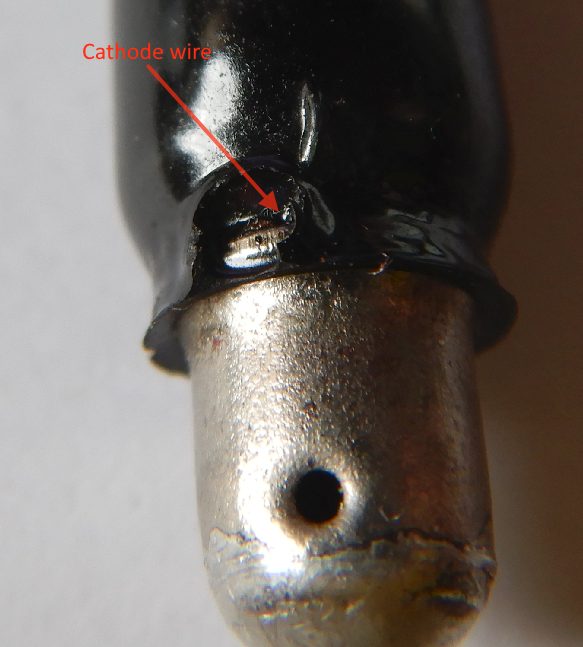
His base shape resembling as a round line of iso force/pressure topology, so when it was formed the paint was necessarily flexible and therefore not dry.
This explains, among other things, why aluminum roll has not changed anything.
In any case it raises a mystery
excellent diagram, the Chinese should have read it before making their tube :-)
|
Mastery is acquired by studying, with it everything becomes simple |
Edited by - Damien68 on 08/30/2020 06:04:28 |
 |
|
| Reply #33
Damien68
    
France
780 Posts |
 Posted - 08/30/2020 : 06:23:25 Posted - 08/30/2020 : 06:23:25


|
certainly it is baked paint. and there must have been a pocket of confined air inside the cap (between sealing and glass) which pressurizes (with the oven heat) and then forming the bubble.
there is a ventilation hole on the cap to allow soldering, but there may be another one non-communicating air pockets btween sealing and glass.
for welding, the ventilation hole is necessary, otherwise during cooling, the weld (still viscous) would excavate because of the depression in the cap cooling down and it would end up making a dry weld |
Mastery is acquired by studying, with it everything becomes simple |
Edited by - Damien68 on 08/30/2020 09:34:09 |
 |
|
| Reply #34
Damien68
    
France
780 Posts |
|
| Reply #35
Damien68
    
France
780 Posts |
 Posted - 08/30/2020 : 07:53:23 Posted - 08/30/2020 : 07:53:23


|
| you must be right, I couldn't find a website in English but potassium carbonate (K2CO3) is widely used in glass manufacture, potassium can also be used as an additive in other forms. |
Mastery is acquired by studying, with it everything becomes simple |
Edited by - Damien68 on 08/30/2020 08:07:30 |
 |
|
| Reply #36
Damien68
    
France
780 Posts |
 Posted - 08/30/2020 : 08:53:38 Posted - 08/30/2020 : 08:53:38


|
Einstein was German like you
... |
Mastery is acquired by studying, with it everything becomes simple |
Edited by - Damien68 on 08/30/2020 09:05:22 |
 |
|
| Reply #37
ullix
    
Germany
1222 Posts |
 Posted - 08/30/2020 : 21:53:01 Posted - 08/30/2020 : 21:53:01


|
@Reply 32: good observation again. Using a strong magnifier I could now recognize the white-grey banana shaped mark just north of the tip of your arrow as the rest of the cathode wire. At its north it disappears into the glass. As far as I can tell it is still all covered with paint.
@Reply 34: I take it that the number of emojis is proportional to your awareness about the dangers of this light! But is it really 254nm light? What makes me wondering: the Amazon pictures show it rather leisurely placed in the kitchen and living room. However, @ 254nm you must ensure that no people are present who could look into that light or who could be exposing their skin to this harmful light! And it has a black glass color? That is strange too. I have seen such dark glass color only in the type of black party lights, which is not harmful. Staining quartz glass black is a possibility, but why do it?
But if it is 254nm then we have 4.88eV photons. Looking at the work functions in my Reply#31 these photons would kick out electrons from almost everything else; to name just those of greater technical relevance: Calcium, Zinc, Magnesium, Aluminum, Cadmium, Manganese, Lead, Silver, Tin, Mercury, Chromium, Copper, Silicon, Iron! It is probably impossible to manufacture anything without at least one of those. There should be a strong photo-effect of this light.
However, there may not be one. Assuming that the light needs to reach the interior of the tube (is that a necessary assumption?) it has to pass the glass wall of the M4011 tube.
Germicidal lamps, like your lamp supposedly is, emitting 254nm are regular fluorescent lamps except for two important differences: 1) there is no white coating in the inside which does the conversion of UV to white light, and 2) lamp glass is a special, more expensive quartz glass, which allows the passing of 254nm. Thankfully, regular glass absorbs all 254nm light.
The M4011 tube glass is surely not quartz glass, but is it thick enough to absorb all 254nm? If it is, we may not see any effect at all.
We also don't know if the black paint of the M4011 is still black for this 254nm UV light, or perhaps transparent?
Looking forward to see your results.
|
 |
|
| Reply #38
Damien68
    
France
780 Posts |
 Posted - 08/30/2020 : 22:55:07 Posted - 08/30/2020 : 22:55:07


|
I may have just made a dumpling, the black in the tube seems to me now to be fluorescent UVA powder.
Fluorescent tubes (germicidal or not) are based on mercury (Hg) vapor. the emitted spectrum therefore corresponds to the energy gain that can be taken by a electron in a excited mercury atom after having been struck by a free electron. (atomic orbital ...)
it emits rays predominantly at wavelengths of 253.7 and 185 nanometers.
https://en.wikipedia.org/wiki/Fluorescent_lamp
The lamp I mentioned, I select it because it is the only one that Amazon has in stock in its warehouses in France and therefore imported by amazon, it is not necessarily by chance and it is surely the only who is not dangerous.
we find others like this next one at amazon but you have to import them from China, I don't know if it's legal, but if it isn't and if you buy it, it's you (the importer) who are in violation and exposed to a ticket, and to assume all the consequences:
                                         
                                                             
                                         
                                                             
                                                             
                                                             

                                         
                                                             
                                         
                                                             
                                                             
                                                             
Image of skull from: https://www.wish.com/product/5dbfc1474b60cc002822922d , https://www.wish.com/product/5d41164010b09f413c43831c and https://www.papado.fr/produit/sticker-tete-de-mort
we can certainly adjust the balance between the ray radiation (253.7 and 185 nanometers) by adjusting the energy of the free electrons (by changing the electric field between the two electrodes of the tube)
Well! it comes out of the subject and interests, I'm going to forget that. |
Mastery is acquired by studying, with it everything becomes simple |
Edited by - Damien68 on 09/01/2020 00:07:10 |
 |
|
| Reply #39
Damien68
    
France
780 Posts |
 Posted - 08/31/2020 : 00:27:43 Posted - 08/31/2020 : 00:27:43


|
now we know why some black tubes are still sensitive to light,
remains the question why some transparent tubes are sensitive to light and others are not, certainly (with good confidence) because there would be potasium in the glass or elsewhere. if it, at the same time it must increase the background because of the K40 presence. by what order of magnitude? |
Mastery is acquired by studying, with it everything becomes simple |
Edited by - Damien68 on 08/31/2020 01:21:08 |
 |
|
| Reply #40
CCCComboBreaker
 
Germany
14 Posts |
 Posted - 08/31/2020 : 08:07:43 Posted - 08/31/2020 : 08:07:43


|
Registered here specifically to tell you that I am following your discussion and love it! Brilliant how you figured things out. Superb.
By the way, I too very recently bought the CAJOE Geiger unit. The tube is clear glass. The print on the tube says 2020II, which suggests it is a very recent version. I will test it and keep you updated. (Subjectively, it ticks closer to 50 times than to 25 here on my brightly-lit desk.) |
Edited by - CCCComboBreaker on 08/31/2020 09:51:04 |
 |
|
| Reply #41
Damien68
    
France
780 Posts |
 Posted - 08/31/2020 : 09:59:59 Posted - 08/31/2020 : 09:59:59


|
| Thanks! it's rewarding and it's nice. |
Mastery is acquired by studying, with it everything becomes simple |
 |
|
| Reply #42
CCCComboBreaker
 
Germany
14 Posts |
 Posted - 08/31/2020 : 11:01:27 Posted - 08/31/2020 : 11:01:27


|
Ok, the first measurements I just took do not suggest light sensitivity. Will now measure over a couple of hours or so and report back. Please just give me some time to set up a solution where I do not have to leave my laptop running all the time, maybe storing the readings to the arduino EEPROM or an SD card instead of sending them to the laptop via serial.
I do not have a science background, I am from a very different field and merely an enthusiast. Did I get it right that the light from a bright desk lamp is sufficiently powerful to trigger the photoelectric effect, if the tube is potassium-contaminated? I also understand that the more light, the better if you want to deliberately induce the effect (as long as the light is above the reddish spectrum)?
|
Edited by - CCCComboBreaker on 08/31/2020 11:02:07 |
 |
|
| Reply #43
CCCComboBreaker
 
Germany
14 Posts |
 Posted - 08/31/2020 : 11:14:04 Posted - 08/31/2020 : 11:14:04


|
| On a sidenote, do you know by any chance what the two "P100" pins on the CAJOE board do? |
 |
|
| Reply #44
CCCComboBreaker
 
Germany
14 Posts |
 Posted - 08/31/2020 : 11:31:55 Posted - 08/31/2020 : 11:31:55


|
By the way, while the tube on my unit looks exactly the same as your M4011s, mine has J305 printed on it, followed by two hard-to-read letters, probably "Br". I would post a picture, but the print faces the board and is barely readable. You can just barely read the shadow on the board.
I think M4011 and J305 are just different labels for the same design. With my J305, the cathode pin pierces the tube glass, too. |
 |
|
| Reply #45
Damien68
    
France
780 Posts |
 Posted - 08/31/2020 : 11:40:14 Posted - 08/31/2020 : 11:40:14


|
with GQ counters there is a Flash inside which allows all information to be recorded without having to use a computer, after you can download all to analyze them with a PC. this is one of GQ's best asset.
With the CAJOE meter there are no functions like this because no flash memory on the meter, well I do not know it too much but I think that we have no other choice than to leave the meter connected to a PC.
otherwise there are some M4011 tubes that are sensitive to light and others that are not (presumably due to potassium contamination). for the moment we cannot know which are and which are not.
but sensitivity starts with green light and continuous with stronger radiation (blue, violet, UV light ...) and the number of detections increases with the power of light.
for P100, I'm not sure at all, it's just a speculation, I just saw an image of the CAJOE PCB, but p100 could be the same signal as the audio jack signal for can be interfaced with an arduino for example . |
Mastery is acquired by studying, with it everything becomes simple |
Edited by - Damien68 on 08/31/2020 11:51:29 |
 |
|
| Reply #46
Damien68
    
France
780 Posts |
 Posted - 08/31/2020 : 11:47:23 Posted - 08/31/2020 : 11:47:23


|
| J305 and M4011 are very close but J305 is 1.7cm more longer than M4011 but aparently same technology. |
Mastery is acquired by studying, with it everything becomes simple |
 |
|
| Reply #47
Damien68
    
France
780 Posts |
 Posted - 08/31/2020 : 11:49:53 Posted - 08/31/2020 : 11:49:53


|
| letter should be betta gamma (in Greek) it's the radiation detected by the tube |
Mastery is acquired by studying, with it everything becomes simple |
 |
|
| Reply #48
CCCComboBreaker
 
Germany
14 Posts |
 Posted - 08/31/2020 : 12:21:14 Posted - 08/31/2020 : 12:21:14


|
quote:
Originally posted by Damien68
letter should be betta gamma (in Greek) it's the radiation detected by the tube
Thanks, that's it! |
Edited by - CCCComboBreaker on 08/31/2020 12:21:53 |
 |
|
| Reply #49
CCCComboBreaker
 
Germany
14 Posts |
 Posted - 08/31/2020 : 12:32:08 Posted - 08/31/2020 : 12:32:08


|
quote:
Originally posted by Damien68
J305 and M4011 are very close but J305 is 1.7cm more longer than M4011 but aparently same technology.
Will make sure to point out that I tested the J305, not the original M4011, when uploading measurements/plots later on. |
 |
|
| Reply #50
CCCComboBreaker
 
Germany
14 Posts |
 Posted - 08/31/2020 : 12:52:48 Posted - 08/31/2020 : 12:52:48


|
quote:
Originally posted by Damien68
with GQ counters there is a Flash inside which allows all information to be recorded without having to use a computer, after you can download all to analyze them with a PC. this is one of GQ's best asset.
With the CAJOE meter there are no functions like this because no flash memory on the meter, well I do not know it too much but I think that we have no other choice than to leave the meter connected to a PC.
otherwise there are some M4011 tubes that are sensitive to light and others that are not (presumably due to potassium contamination). for the moment we cannot know which are and which are not.
but sensitivity starts with green light and continuous with stronger radiation (blue, violet, UV light ...) and the number of detections increases with the power of light.
for P100, I'm not sure at all, it's just a speculation, I just saw an image of the CAJOE PCB, but p100 could be the same signal as the audio jack signal for can be interfaced with an arduino for example .
I hooked up the CAJOE Geiger tube PCB to an Arduino. The number of ticks per minute is logged to the Arduino EEPROM. This solution is very basic, but anyway.
(A more sophisticated approach could be hooking up everything to a raspberry pi and gnuplotting the values there. A lamp could be plugged into a wlan or 433mhz power socket, and the raspberry would connect to the socket, with a cronjob turning it on and off. That's probably the safest/easiest solution for more "lab-like" measurements.) |
Edited by - CCCComboBreaker on 08/31/2020 13:13:28 |
 |
|
| Reply #51
ullix
    
Germany
1222 Posts |
 Posted - 08/31/2020 : 23:32:34 Posted - 08/31/2020 : 23:32:34


|
@CCCComboBreaker: Welcome!
As a Cajoe user you might be interested in my article GeigerLog-Radiation-v1.1(CAJOE)-Support-v1.0.pdf, which you find on my Sourceforge site under Files -> Articles: https://sourceforge.net/projects/geigerlog/.
This article also has the details on the P100:
quote:
P100 (Right, Top, WD-C3) connects the pulse signal to the audio connector. If you want to hear any clicks on your earphones, or want to connect the Cajoe-Counter to GeigerLog, then these two pins must be shorted, i.e. a jumper must be set!
and a whole lot more.
Since you describe yourself as a non-scientist, I'd again recommend my "Potty-Training" as a kind of starter for Geiger counter use: https://sourceforge.net/projects/geigerlog/files/Articles/GeigerLog-Potty%20Training%20for%20Your%20Geiger%20Counter-v1.0.pdf/download
The J-tubes are a broad offer of tubes, made from glass and also from metal: You find an overview here (scroll way down): https://german.alibaba.com/product-detail/geiger-tube-m4011-for-high-doses-of-radiation-detection-gieiger-muller-tube-60432321599.html
My guess is the J-company is different from the one making the M4011, but not certain. Info is hard to come by.
Since you consider running a Raspi, I suggest trying GeigerLog. Once Python3 is installed, you can use GeigerLog also on a Raspi.
To test for light sensitivity it is preferable to use LED light, as incandescent sources of sufficient intensity produce too much heat. A regular white LED (cold white better than warm white), but of course blue, violet, and UV-X LEDs are even better.
With your location in Germany, getting CPM=50 seems to be really on the high side! I'd expect something below 20 or not much above. The variation between tubes does not explain this observed magnitude. Check your setup, something seems wrong. Is the interrupt signal to the Arduino clean enough, or perhaps firing multiple times per click? Count the audio clicks manually with a stopwatch - still getting CPM=50?
|
 |
|
| Reply #52
ullix
    
Germany
1222 Posts |
 Posted - 09/01/2020 : 00:00:06 Posted - 09/01/2020 : 00:00:06


|
@Damien: A thorough warning about the use of UV-C light is certainly justified, but there is absolutely nothing illegal about manufacturing and selling them. The best manufacturer in my view is Philips. https://www.lighting.philips.com/main/products/uv-disinfection
I used these tubes myself intensively in a microbiological lab to keep the cleanbenches free from any bacterial, fungal, and viral contamination. I sure works!
But I doubt if you can shift the emission between 185nm and 254nm by fiddling with the voltage. If you could, I am sure Philips has already done it and implemented it, because 185nm is undesirable, since it produces ozone. The glass of the ozone-free tubes is modified to block passage of 185nm, so only 254nm (and longer) gets through.
There is no legality issue. Just be aware of the danger this light has to all living matter, not just the bugs it is intended to kill!
By the way: I was shopping for UV-C LEDs. They exist but I found no source for small quantities. So far the offerings of all Chinese sources turned out to be fake, selling violet LEDs as UV-C LEDs. Anyone has a suggestion?
|
 |
|
| Reply #53
Damien68
    
France
780 Posts |
 Posted - 09/01/2020 : 00:10:36 Posted - 09/01/2020 : 00:10:36


|
may be
but sometimes you can sell products in devices and have restrictions for the spare parts alone which can be dangerous without the security around.
in fact I don't know, but if it legal in this form it's still dangerous, I don't want to advertise it without raising awareness.
In general, you still have to be careful about products imported directly from China or elsewhere, whether through Amazon or another trade site, if the product is regulated, if it is a counterfeit, if the invoce is under estimated or what, the importer is primarily responsible.
for UVC lamp, they are widely used in devices to sterilize, but they are provided with warnings, protections, screens, ....
like that on a socket, I don't know if it's legal or responsible.
|
Mastery is acquired by studying, with it everything becomes simple |
Edited by - Damien68 on 09/01/2020 01:46:55 |
 |
|
| Reply #54
CCCComboBreaker
 
Germany
14 Posts |
 Posted - 09/01/2020 : 01:23:39 Posted - 09/01/2020 : 01:23:39


|
@ullix:
Checked out your sourceforge. Leaves me in awe how much effort you put into this and how deep you went. Will try and get this up and running and post my plots later on.
EDIT: I am now reading your CAJOE unit .pdf and it's GREAT!!! |
Edited by - CCCComboBreaker on 09/01/2020 03:46:59 |
 |
|
| Reply #55
CCCComboBreaker
 
Germany
14 Posts |
 Posted - 09/01/2020 : 01:31:49 Posted - 09/01/2020 : 01:31:49


|
An observation: After powering the unit for a couple of hours, the inside of the tube walls seem to now have like a spectral color coating. It looks a bit like eloxed aluminium (?). Before, the glass was completely clear. Did you observe that too? What would explain this?
EDIT: ullix, I checked out your .pdf. Your geiger tube looks the same, see Fig. 2 with the Geiger tube in a plastic bag.
EDIT: After checking various pictures from the internet, I am not so sure anymore that the tube did not look like this from the beginning. Maybe I did not notice it initially and just did so now? |
Edited by - CCCComboBreaker on 09/01/2020 02:15:02 |
 |
|
| Reply #56
Damien68
    
France
780 Posts |
 Posted - 09/01/2020 : 01:42:22 Posted - 09/01/2020 : 01:42:22


|
the tube is metalized inside with tin oxide, this is what diffracts the light.
it depends on how the tube is lit (incidence of light rays) and also on the angle with which you look at it. |
Mastery is acquired by studying, with it everything becomes simple |
Edited by - Damien68 on 09/01/2020 01:49:28 |
 |
|
| Reply #57
Damien68
    
France
780 Posts |
 Posted - 09/01/2020 : 03:26:25 Posted - 09/01/2020 : 03:26:25


|
Depending of the exposures, UVCs can be seriously dangerous,
I found the ISO 15858 standard describing its effects at low dose:
https://www.iso.org/obp/ui/#iso:std:iso:15858:ed-1:v1:en
So there are aparently specific standards for UVC devices.
I leave anyway the photo of Bebert (post #38) who was toasted with its UVC lamp  |
Mastery is acquired by studying, with it everything becomes simple |
Edited by - Damien68 on 09/01/2020 05:42:10 |
 |
|
| Reply #58
Damien68
    
France
780 Posts |
 Posted - 09/01/2020 : 05:48:56 Posted - 09/01/2020 : 05:48:56


|
I found one lampe stock at amazon europe warehouse.
185nm + 265nm
185nm make ozone
https://www.amazon.fr/gp/product/B07XD1SHWF/ref=ox_sc_act_title_1?smid=A3J1QXSJKH0ADS&psc=1
if buy it, be very careful, read all the comments on the site about UVA and about Ozone too.
if the UV rays can pass through the glass of the M4011, that should make my GMC-500 go crazy with my half un-blacked tube |
Mastery is acquired by studying, with it everything becomes simple |
Edited by - Damien68 on 09/01/2020 06:27:14 |
 |
|
| Reply #59
CCCComboBreaker
 
Germany
14 Posts |
 Posted - 09/01/2020 : 10:04:07 Posted - 09/01/2020 : 10:04:07


|
quote:
Originally posted by ullix
Since you consider running a Raspi, I suggest trying GeigerLog. Once Python3 is installed, you can use GeigerLog also on a Raspi.
|
 |
|
| Reply #60
CCCComboBreaker
 
Germany
14 Posts |
 Posted - 09/01/2020 : 10:43:35 Posted - 09/01/2020 : 10:43:35


|
@ullix please help me with this:
I want to use my Cajoe counter with a raspi. I have the first/original model B. I installed everything and seemingly it works. The old raspi seems powerful enough as the software starts up and is reactive. HOWEVER, only now I realized that there is no way of connecting the cajoe counter to the raspi! The raspi has an audio jack, but it is only output. It has USB ports too, but the cajoe unit does not output data via USB. Its USB cable is only a power supply.
It should be easy to solve this, because the cajoe unit transmits the clicks via a pin, too. I imagine you would have to connect the cajoe unit pin to a raspi hardware interrupt pin. Then in the geigerlog software, you would attach a (falling) interrupt to it; everything else should mostly be parallel to the other input approaches. BUT: This goes beyond my programming knowledge at this point. Is there any chance for you to consider implementing this in geigerlog? Or could you at least guide me in the right direction?
(Note to self: Cajoe output pin is 5v, raspi logic voltage is 3.3v, so maybe a resistor is needed in between? And cajoe and raspi grounds must be connected, I think.) |
 |
|
| Reply #61
GBG12
    
Canada
103 Posts |
|
| Reply #62
CCCComboBreaker
 
Germany
14 Posts |
 Posted - 09/01/2020 : 22:54:32 Posted - 09/01/2020 : 22:54:32


|
quote:
Originally posted by GBG12
The answer is a USB microphone. GQ sells one:
https://www.gqelectronicsllc.com/comersus/store/comersus_viewItem.asp?idProduct=4544 that works under Windows. Also many alternatives like Ugreen, etc. Some of these should unumerate under Raspian as an audio input device with the correct driver.
Thank you for your suggestion. However, I would have to buy another cable for €€ where the same result could be achieved with a simple jumper wire between the pins... |
 |
|
| Reply #63
CCCComboBreaker
 
Germany
14 Posts |
 Posted - 09/01/2020 : 22:57:54 Posted - 09/01/2020 : 22:57:54


|
| *The forum autocorrected the two Euro Symbols to "AA" and does not let me edit my post... |
 |
|
| Reply #64
ullix
    
Germany
1222 Posts |
 Posted - 09/01/2020 : 23:43:08 Posted - 09/01/2020 : 23:43:08


|
@combo: sorry, I overlooked the missing audio input on a Raspi. Indeed, an "external sound card", aka an audio-to-USB converter might be the answer.
However, given GQ's description of their product I am not sure it is plain-vanilla enough for the job? Googling for "Plugable USB Audio Adapter" seems to give offers for Raspi at ~8#8364;, but I have never tested them.
Handling interrupts should be possible, but as I am currently preparing my 1.0 release of GeigerLog I will at this time make no attempts to further extend GL. |
 |
|
| Reply #65
ullix
    
Germany
1222 Posts |
 Posted - 09/02/2020 : 00:57:20 Posted - 09/02/2020 : 00:57:20


|
A real datasheet on the M4011 tube could be really helpful. But whatever datasheet is out there is lousy, and that is already a glorifying description! There is never the manufacturing company mentioned, let alone a letterhead of the company being shown. Why this secrecy? The trustworthiness of the data is highly doubtful! And unfortunately, GQ never made any attempts to correct this. So whatever argument is based on such information needs to be taken with great caution!
One piece of such info is "Tin oxide Cathode". Tin oxides are at least SnO, SnO2, Sn2O3, which one is it? But oxides of metals tend to be insulators, how does that fit with the need for a cathode which has to be a conductor? And does it mean the manufacturing process starts with metallic tin, which is evaporated, and then oxidized (by letting air into the tube), or does it mean they start with the oxide, then heat it up, which does result in the decomposition into other forms of tin oxide plus its metallic form, which then may condense on the inner wall?
What actually is the substance on the inner wall of a M4011 tube? One usually sees rainbow colors at the tubes' wall, but there are reports of tubes, which show a grayish layer instead - as if oxidized and thereby destroyed - yet this tube still seems to work perfectly well in a Geiger counter?
We know the Photoelectric Work Functions of the elements. How do they change when we do not have the pure atoms, but molecules, like oxides?
A whole lot remains unknown.
My working assumption is that the rainbow colors result from a metallic tin deposit in the thickness of 300...600 nm, the wavelengths of visible light.
If so, then we should be able to kick out photo-electrons by irradiating the tubes with light of at least the wavelength equivalent to the work fucntion. Tin has a rather high work function of 4.42eV, equivalent to 280.5nm, which is UV-C. Perhaps the reason for choosing tin, as ambient sun or artificial light cannot activate its electrons?
I have updated the work function diagram to show tin and a few more light sources:
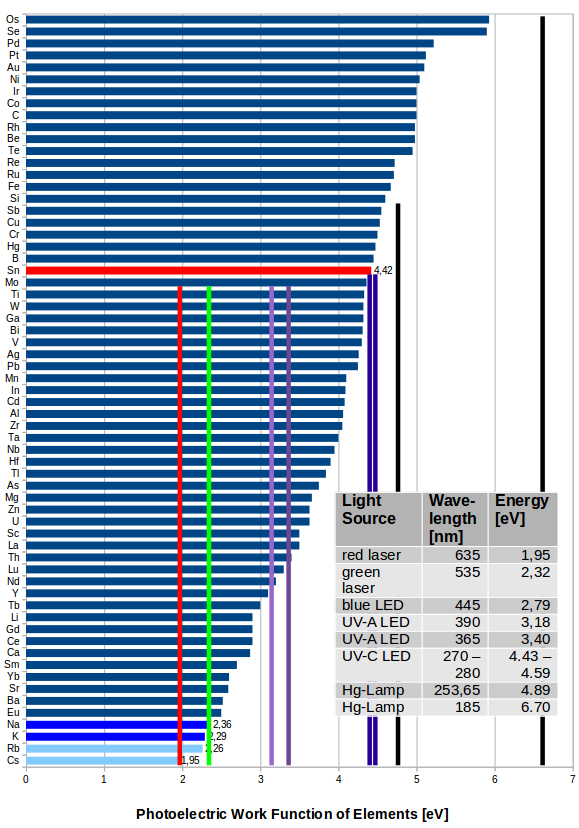
The 254nm line from a Hg-Lamp - Damien's darling - would certainly activate tin. (And of cause so would the 185nm line from an Hg-Lamp, but I would stay away from anything ozone producing. Why sit coughing at my desk and wondering about unexpected side effect? Ozone is chemically highly active and could do more damage than just killing bugs.)
Then there are UV-C LEDs. Unfortunately, there output wavelength are somewhere in the range of 270...280nm, which is again borderline for tin activation. Might work, might not.
If it works as expected, then illuminating a M4011 tube with that light should really result in a burst of "counts" in the counter.
|
 |
|
| Reply #66
Damien68
    
France
780 Posts |
 Posted - 09/02/2020 : 01:29:17 Posted - 09/02/2020 : 01:29:17


|
@CCCComboBreaker
If you are passionate about it and feel like it, you can also make your own application. Personally that's what I did on my PC / Windows because I'm a bit of a freak and I like having the buttons that I want, where I want and I like them to do what I want. And in the end it is not very complex. but there is still a lot to do.
For someone who wants to exercise, this is a good project. :-) |
Mastery is acquired by studying, with it everything becomes simple |
Edited by - Damien68 on 09/02/2020 01:30:19 |
 |
|
| Reply #67
Damien68
    
France
780 Posts |
 Posted - 09/02/2020 : 02:03:06 Posted - 09/02/2020 : 02:03:06


|
@ullix
yes all this is not really clear to me either, it is really a chemist's thing.
I found a article about:
https://en.wikipedia.org/wiki/Electron_configuration
effectively, to have diffraction in this kind of configuration, the thickness of the metalization must be around the same magnitude as the wavelength of the diffracted light, which causes an interference between two reflexions.
the two reflexions come from two interfaces.
the first interfaces is between the glass and the metalization layer, the second interface is between the metalization layer and the gas inside the glass.
each of this 3 material have different refractive indices, so we get two reflections that will interfer.
EDIT: Note: There is also a third interface which is the external surface of the tube (interface between the glass of the tube and the external air) but as the thickness of the glass is immense compared to the wavelengths of which we are interested, we will have no visible interference generated by this interface.
|
Mastery is acquired by studying, with it everything becomes simple |
Edited by - Damien68 on 09/02/2020 17:41:28 |
 |
|
| Reply #68
Damien68
    
France
780 Posts |
 Posted - 09/02/2020 : 02:41:36 Posted - 09/02/2020 : 02:41:36


|
| I'm not going to cough, I'm going to do this outside, and use a drone to see what's going on and take pictures. :-) |
Mastery is acquired by studying, with it everything becomes simple |
 |
|
| Reply #69
Damien68
    
France
780 Posts |
|
| Reply #70
Damien68
    
France
780 Posts |
 Posted - 09/02/2020 : 05:15:10 Posted - 09/02/2020 : 05:15:10


|
If we remove an electron from Tin oxyde molecule, What's going on?
exactly I don't know, it's the kind of thing that you have to study on a case-by-case, to know if the molecule breaks or not we must list all the possibilities, draw their energy diagrams to calculate overall energy of molecule for eachs possibilitys, and find the one that has the minimum one.
This is the general method used in chemistry to know if a reaction will take place or not.
But if M4011 works well, we can presume than Tin oxyde molecule does not break and the missing electron must simply be replaced by a new one from the power supply of the tube.
|
Mastery is acquired by studying, with it everything becomes simple |
Edited by - Damien68 on 09/02/2020 06:55:50 |
 |
|
| Reply #71
Damien68
    
France
780 Posts |
 Posted - 09/02/2020 : 05:25:07 Posted - 09/02/2020 : 05:25:07


|
what energy must be supplied to remove an electron from the tin?
certainly the energy of the one having the minimum one, but it's not necessarily a valence electron who are shared with other atom of its molecule. |
Mastery is acquired by studying, with it everything becomes simple |
 |
|
| Reply #72
Damien68
    
France
780 Posts |
 Posted - 09/02/2020 : 06:51:39 Posted - 09/02/2020 : 06:51:39


|
Poor bebert (see reply 38) he shouldn't have bought his UVC lamp on amazon  |
Mastery is acquired by studying, with it everything becomes simple |
Edited by - Damien68 on 09/02/2020 06:52:59 |
 |
|
| Reply #73
CCCComboBreaker
 
Germany
14 Posts |
 Posted - 09/02/2020 : 11:29:32 Posted - 09/02/2020 : 11:29:32


|
quote:
Originally posted by Damien68
@CCCComboBreaker
If you are passionate about it and feel like it, you can also make your own application. Personally that's what I did on my PC / Windows because I'm a bit of a freak and I like having the buttons that I want, where I want and I like them to do what I want. And in the end it is not very complex. but there is still a lot to do.
For someone who wants to exercise, this is a good project. :-)
Is your project on github? |
 |
|
| Reply #74
Damien68
    
France
780 Posts |
 Posted - 09/02/2020 : 16:50:35 Posted - 09/02/2020 : 16:50:35


|
| is not mine, I did not share it. |
Mastery is acquired by studying, with it everything becomes simple |
Edited by - Damien68 on 09/02/2020 17:22:36 |
 |
|
| Reply #75
Damien68
    
France
780 Posts |
 Posted - 09/03/2020 : 02:59:30 Posted - 09/03/2020 : 02:59:30


|
Test with my non light sensitive M4011 'half' black tube and new 365nm flashlight:
this show 150 CPM (Background part: 33 CPM)

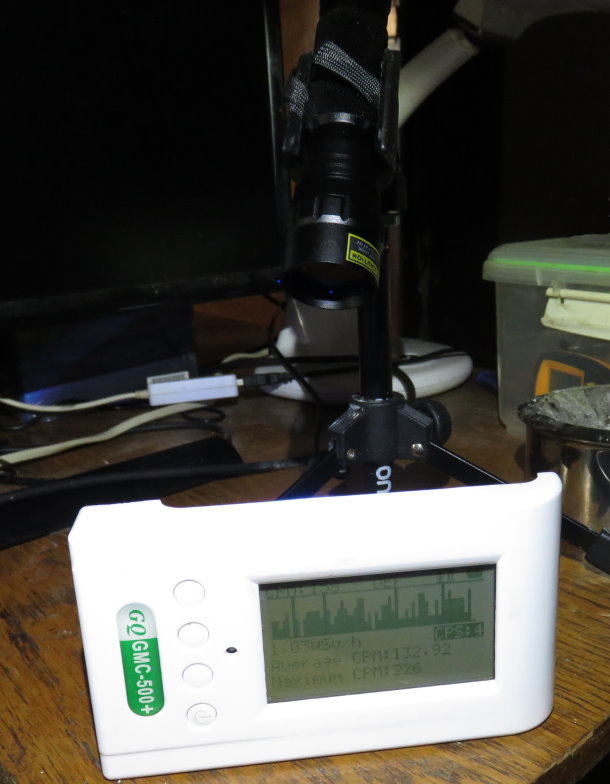 |
Mastery is acquired by studying, with it everything becomes simple |
Edited by - Damien68 on 09/03/2020 04:09:21 |
 |
|
| Reply #76
Damien68
    
France
780 Posts |
 Posted - 09/03/2020 : 03:45:05 Posted - 09/03/2020 : 03:45:05


|
I do same test with green lazer, really no sensitivity, the count stays around 33 CPM at the exact background level, which I just checked again.

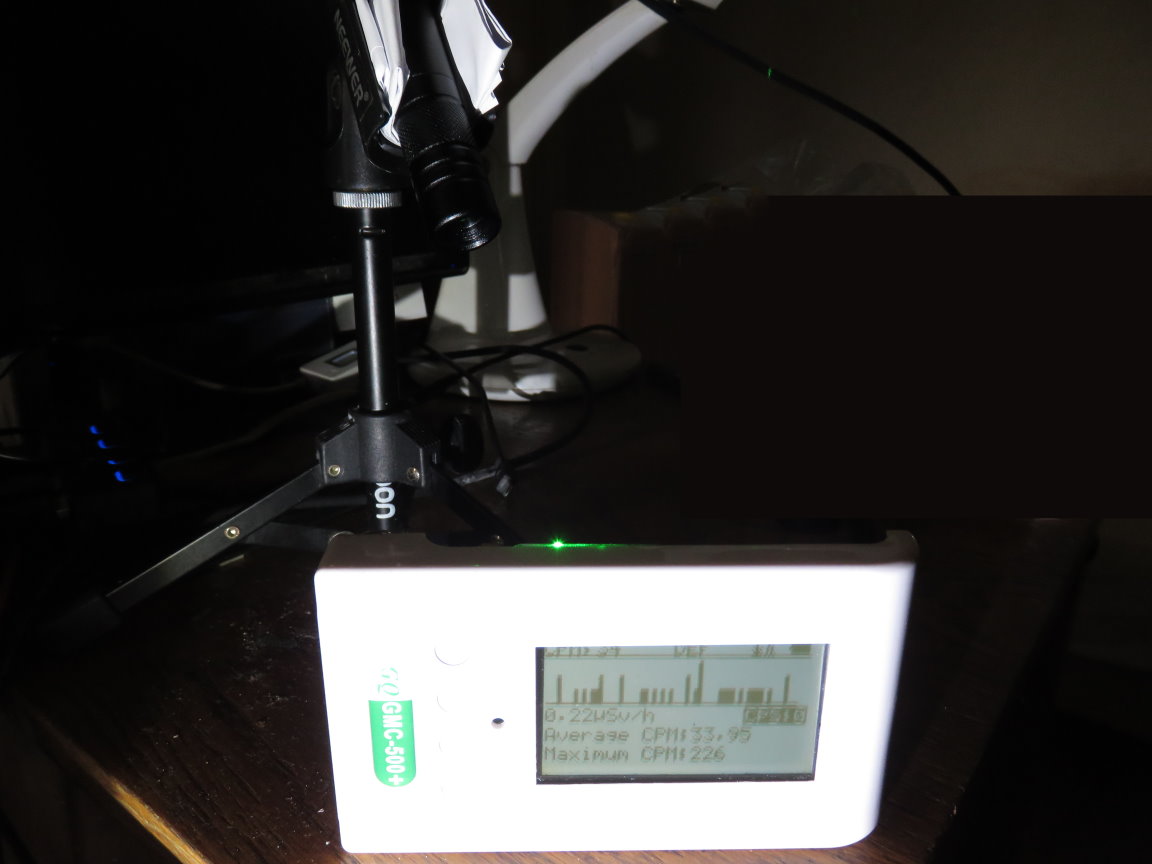
I do many tests with enlighting cathode pad and others, with no reactions |
Mastery is acquired by studying, with it everything becomes simple |
Edited by - Damien68 on 09/03/2020 04:12:07 |
 |
|
| Reply #77
Damien68
    
France
780 Posts |
 Posted - 09/03/2020 : 04:49:08 Posted - 09/03/2020 : 04:49:08


|
Another test with Flashlight 395nm
absolutly no sensitivity.
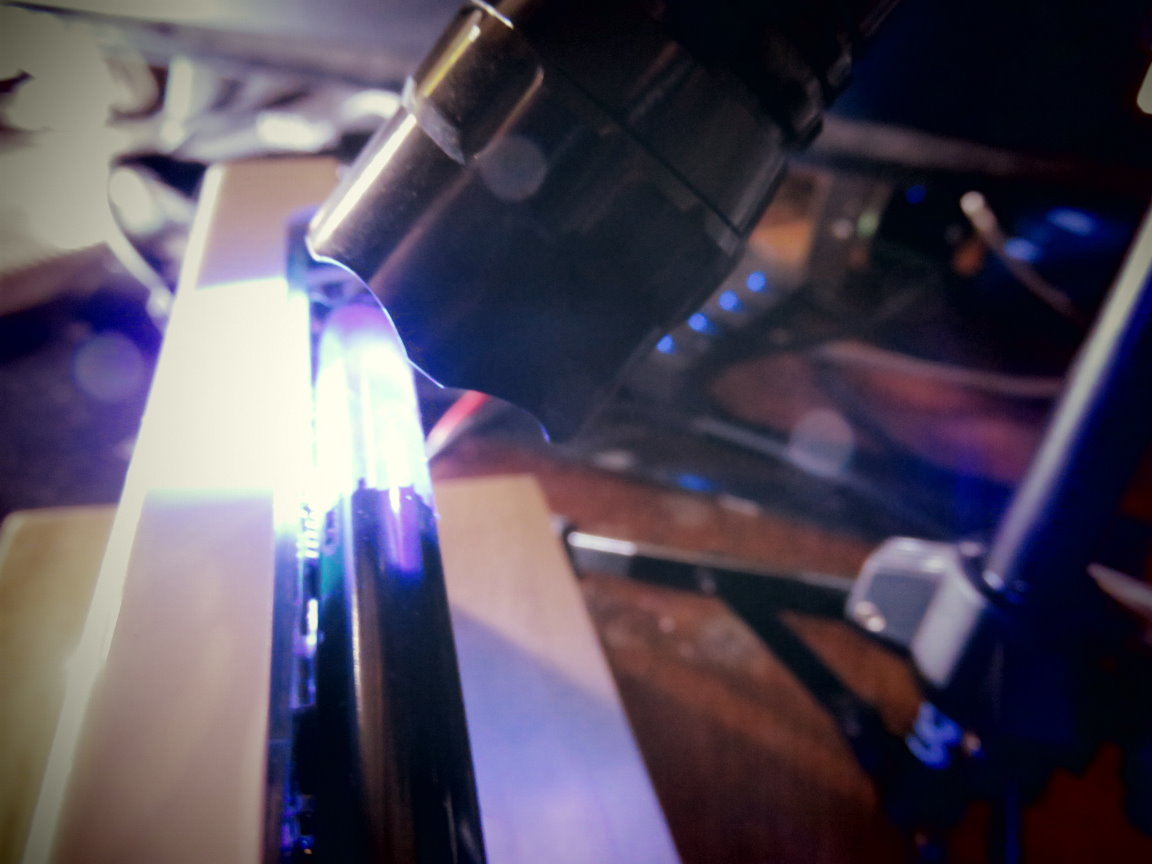
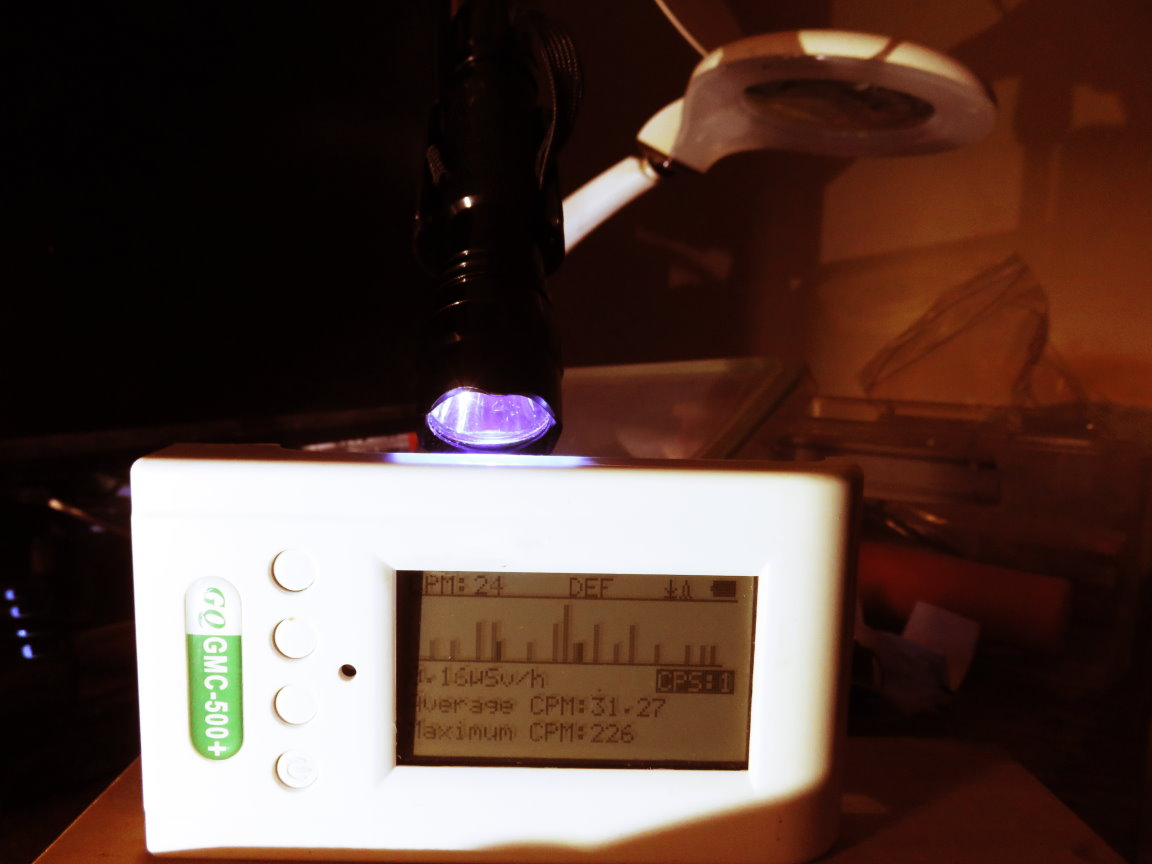 |
Mastery is acquired by studying, with it everything becomes simple |
 |
|
| Reply #78
Damien68
    
France
780 Posts |
 Posted - 09/03/2020 : 05:09:18 Posted - 09/03/2020 : 05:09:18


|
So on my tube, its light sensitivity start between 365 and 395 nm.
following the Ullix table this can caused by :
1. Nd (Neodymium) usefull for magnets
2. Lu (Lutecium) is rare
3. It's a bit borderline but it could also be caused by Th (Thorium), thorium oxide is used to make camera's lens.
4. borderline too, can also be Y Yttrium can be use to do electrodes.
Anyway, no need to do tests with more shorted wavelenghts, unless if we want or to test the effectiveness of the black paint, but mine is compromised. |
Mastery is acquired by studying, with it everything becomes simple |
Edited by - Damien68 on 09/03/2020 05:40:52 |
 |
|
| Reply #79
Damien68
    
France
780 Posts |
 Posted - 09/03/2020 : 06:47:33 Posted - 09/03/2020 : 06:47:33


|
I make some tests with SBM-20-1
is like SMB-20 without end cap, so it have in two extremity an exposed glass insulator.
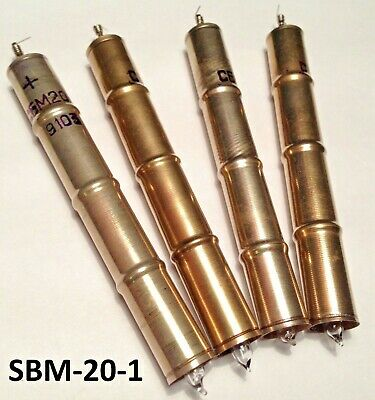
with 365nm Flashlight at 1cm of it extremity, it go up to 400CPM
with green lazer or 395nm flashlight, there is no reaction.
In fact the two tube SBM-20-1 and the M4011 (in it's non-light-sensitive version) behave the same comportement. the SBM20-1 is still radially protected but not on its axis.
|
Mastery is acquired by studying, with it everything becomes simple |
Edited by - Damien68 on 09/03/2020 06:56:56 |
 |
|
| Reply #80
the_mike
   
Switzerland
53 Posts |
 Posted - 09/03/2020 : 10:21:08 Posted - 09/03/2020 : 10:21:08


|
Reading this thread and being completly fascinated about your findings, I just started to ask myself if the SBM-11 (pancake, used in one of the 600 series) or the US-tubes used in "better" models are lightsensitive, too...
Any chance you can test these models, too? |
 |
|
| Reply #81
ullix
    
Germany
1222 Posts |
 Posted - 09/04/2020 : 00:17:12 Posted - 09/04/2020 : 00:17:12


|
quote:
Any chance you can test these models, too?
Sure, no problem. I'd suggest to use the Cajoe counter for experimenting - it is a whole lot cheaper than a GMC counter should you fry anything :-/.
You could connect it to GeigerLog for long-term recording, but even that is not necessary, because you could just listen to the audio clicks. If light does anything, you certainly will hear the increasing count rate!
The one hurdle to take - but that applies to any counter - is a decent way of measuring the anode voltage, because when using different tubes and conditions the voltage should be known! As a reminder: measuring the voltage isn't trivial; I am discussing the issue of a power source with very high internal resistance again in the Cajoe article https://sourceforge.net/projects/geigerlog/files/Articles/GeigerLog-Radiation-v1.1%28CAJOE%29-Support-v1.0.pdf/download and you can also look at the respective sticky here in the forum.
For any serious experimentation you'll need something like a 1 GigaOhm resistor (should be in the single digit $ per piece).
|
 |
|
| Reply #82
the_mike
   
Switzerland
53 Posts |
 Posted - 09/04/2020 : 03:50:05 Posted - 09/04/2020 : 03:50:05


|
I don't have the tubes nor the UV-lights aso...
(sadly, no means to get them atm...) |
 |
|
| Reply #83
Damien68
    
France
780 Posts |
 Posted - 09/04/2020 : 05:19:43 Posted - 09/04/2020 : 05:19:43


|
Neither me,I don't have no LND7317 nor SBM11.
I have a LND712 and I can test it later with 500v. it could be interesting. |
Mastery is acquired by studying, with it everything becomes simple |
Edited by - Damien68 on 09/04/2020 06:26:49 |
 |
|
| Reply #84
Damien68
    
France
780 Posts |
 Posted - 09/05/2020 : 01:00:44 Posted - 09/05/2020 : 01:00:44


|
I tested the M4011 with UVC light,
The tube is not insensitive, but not very sensitive either.
The light must remain blocked by the glass of the tube.
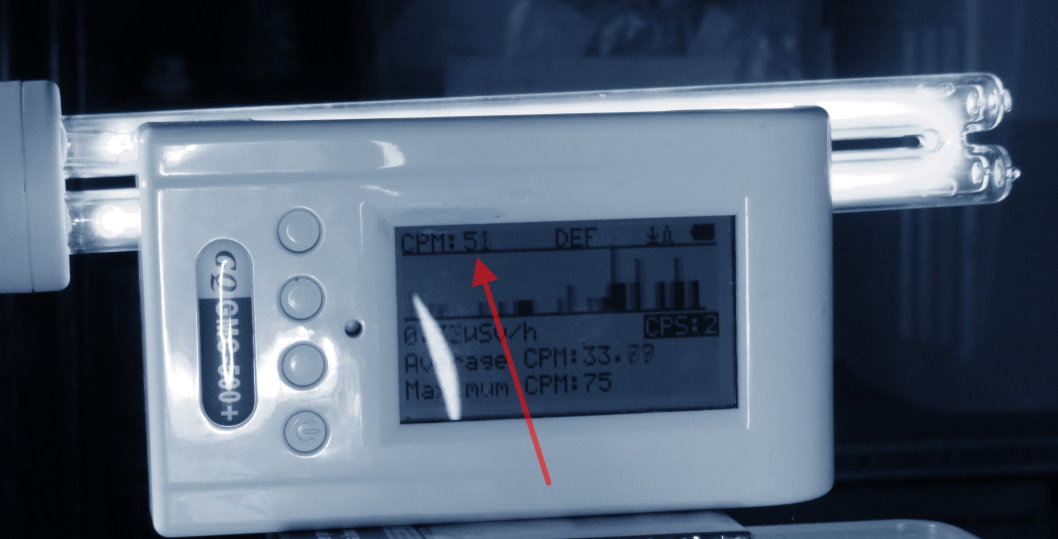 |
Mastery is acquired by studying, with it everything becomes simple |
 |
|
| Reply #85
Damien68
    
France
780 Posts |
 Posted - 09/05/2020 : 01:52:12 Posted - 09/05/2020 : 01:52:12


|
I make some test with LND-712, There are 2 points that I tested:
1: the mica window
2: the glass valve allowing the gas tube to be filled.
see photo bellow:
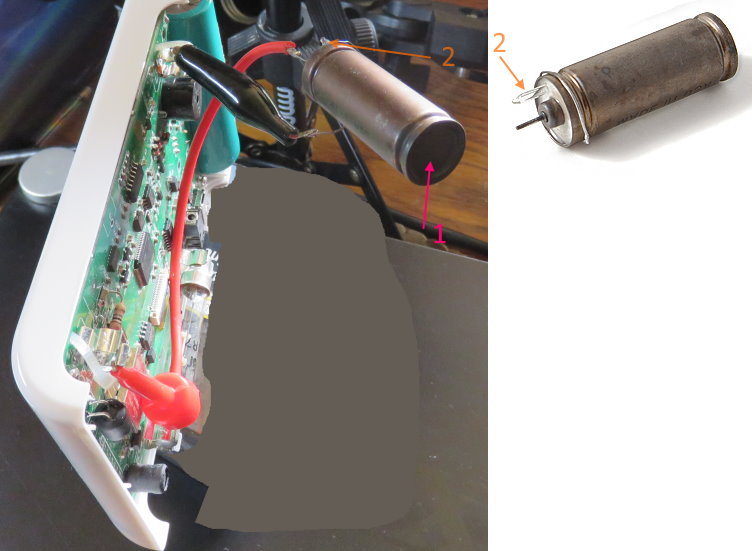
1. in front of the mica window:
- UVA 395 nm: no sensitivity
- UVA 365 nm: no sensitivity
- UVC: slight sensitivity (+30 CPM) at 1cm
2.in front of valve:
- UVA 365 nm: slight sensitivity
- others: not tested
Mica windows, 365nm test:
 |
Mastery is acquired by studying, with it everything becomes simple |
Edited by - Damien68 on 09/05/2020 02:30:30 |
 |
|
| Reply #86
Damien68
    
France
780 Posts |
 Posted - 09/05/2020 : 07:55:24 Posted - 09/05/2020 : 07:55:24


|
To conclude on the LND-712:
we can say that it is totally insensitive to daylight.
it is a little bit sensitive to UVC, and again it's just a quick test so it would have to be confirmed again, but anyway the UVC is absorbed by the air, and the sensitivity would only be really very minimal, we can therefore ignore this point entirely.
Be careful though that the glass valve at the back of the tube cannot be directly exposed to light.
The LND7317 seems to be made with the same materials than LND-712, so it would be surprising if they were sensitive to daylight. |
Mastery is acquired by studying, with it everything becomes simple |
Edited by - Damien68 on 09/05/2020 07:57:23 |
 |
|
| Reply #87
Damien68
    
France
780 Posts |
 Posted - 09/05/2020 : 08:37:46 Posted - 09/05/2020 : 08:37:46


|
@ullix:
on the GMC-500+ there is already a resistance of 1 Gohms to measure the voltage of the tube and we can display it directly on the screen.
For me the measurement is reliable as long as the Lipo battery is not almost completely discharged. |
Mastery is acquired by studying, with it everything becomes simple |
 |
|
| Reply #88
ullix
    
Germany
1222 Posts |
 Posted - 09/05/2020 : 22:59:04 Posted - 09/05/2020 : 22:59:04


|
quote:
but anyway the UVC is absorbed by the air
No way! Why is UV-C light used for surface disinfection? Because it is basically NOT absorbed in the air and reaches the surface of benches, equipment, etc in a microbiologically clean environment.
quote:
on the GMC-500+ there is already a resistance of 1 Gohms to measure the voltage of the tube
That is the first time I hear this. What is the location of this resistor and what its Label on the circuit board (like R999)?
I believe the displayed value is derived by some formula from the position of the potentiometer used for setting the anode voltage. This may be more or less correct, but I doubt it is a true anode voltage measurement!
|
 |
|
| Reply #89
Damien68
    
France
780 Posts |
 Posted - 09/06/2020 : 00:22:29 Posted - 09/06/2020 : 00:22:29


|
UVC are completely absorbed by the ozone layer and atmosphere
you can see wikipedia:
https://en.wikipedia.org/wiki/Ultraviolet#UVC
Moreover the ozone in Earth's stratosphere is continually regenerated by UVC sended by the sun following the process commonly called the Chapman cycle.
https://en.wikipedia.org/wiki/Ozone%E2%80%93oxygen_cycle
this is why on the surface of the earth and in daylight we cannot have UVC at least not in a significant amount.
Afterwards, in artificial light it is different but for the harshest UVCs they will still have a limited coverage because they will be absorbed to creat ozone or other. the coverage can be quite wide, but we are talking about artificial light and not the light filtered by the earth's atmosphere.
For the GMC-500+ at least in its latest revision, there is no potentiometer on the card, the voltage is adjusted by software adjustment (adjustment of the duty cycle of the PWM output driving the transistor of the HV generator)
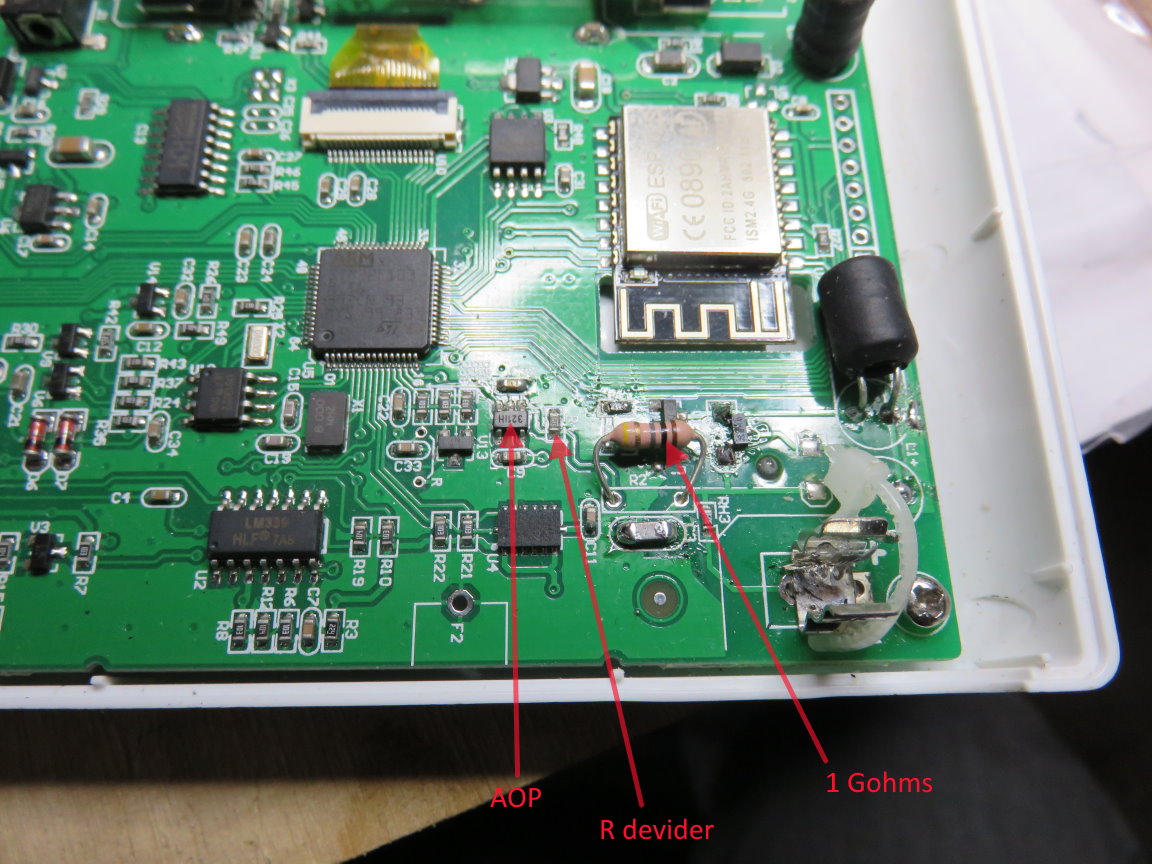
Sorry if you have an older version of the PCB.
R divider marking is 515 so is value is 5.1 Mohms which makes a voltage divider of 5.1 / 1005.1 = 1/197
And Tube1 voltage can be displayed:
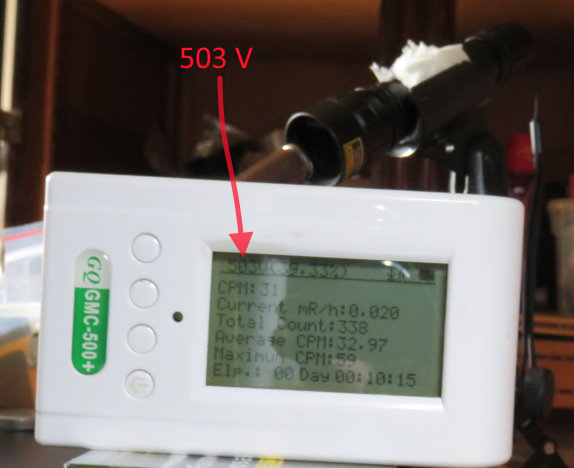
|
Mastery is acquired by studying, with it everything becomes simple |
Edited by - Damien68 on 09/06/2020 01:14:30 |
 |
|
| Reply #90
Damien68
    
France
780 Posts |
 Posted - 09/06/2020 : 00:40:55 Posted - 09/06/2020 : 00:40:55


|
After passing the 1 Gohms resistor and Rdivider and small capacitor (to remove signal noise), the signal is buffered by an operational amplifier (AOP), and go to an analog Input of microcontroller who measure the voltage with an Analog to digital converter.
I make some test and at least on my GMC-500+ hardware V5.2, soft v2.18 the indicated voltage is indeed that measured, in my case it's not an extrapolation of the setpoint. |
Mastery is acquired by studying, with it everything becomes simple |
Edited by - Damien68 on 09/06/2020 01:05:16 |
 |
|
| Reply #91
Damien68
    
France
780 Posts |
 Posted - 09/06/2020 : 08:25:15 Posted - 09/06/2020 : 08:25:15


|
@ullix:
on your post http://www.gqelectronicsllc.com/forum/topic.asp?TOPIC_ID=5369&whichpage=1
effectively you have a hardware revision 3.1 without hardware voltage reading. GQ must have catched your idea without warning you.  
 nor rewarding you either nor rewarding you either    
PS: This changes absolutely nothing to the normal operation of the device because there is no servo regulator using the voltage measurement to control the PWM output. |
Mastery is acquired by studying, with it everything becomes simple |
Edited by - Damien68 on 09/07/2020 00:18:49 |
 |
|
| Reply #92
ullix
    
Germany
1222 Posts |
 Posted - 09/07/2020 : 00:18:28 Posted - 09/07/2020 : 00:18:28


|
quote:
UVC are completely absorbed by the ozone layer and atmosphere
Are you trying to suggest that from the fact that solar UV-C is absorbed by a 10 km Ozone layer, followed a few 10km air, your UV-C light is absorbed from a lightpath of a few mm in the ozone free environment of your apartment and therefore cannot have an effect on a Geiger tube? Give it a try: put the lamp up and sit 1 meter away in front of it. With your theory nothing will happen to you. (NO, DON'T DO THIS! You would get very severe burns!)
Well, the addition of 1 GOhm sure looks like an afterthought, given the soldering job done. But it sure is a good move. It is sometimes called a banana strategy: the bananas ripen when in the hands of the customers. Read the GMC500+ review and just imagine how much GQ got out of this donation of 100 bucks! Perhaps it's time for another donation ;-)
|
 |
|
| Reply #93
Damien68
    
France
780 Posts |
 Posted - 09/07/2020 : 00:30:25 Posted - 09/07/2020 : 00:30:25


|
What I'm trying to say is just that the natural UVCs (those from the sun) won't get through the tube.
Then I also said that there will be an attenuation of the harshest UVC (185nm) that can come from a lamp since they create ozone, photon therefore was absorbed to split O2 molecule. But it is true that it is not necessarily a very strong attenuation.
Anyway with my 185nm lampe the M4011 tube has only a very moderate sensitivity, it is certainly the glass of its tube that protects it from this.
|
Mastery is acquired by studying, with it everything becomes simple |
Edited by - Damien68 on 09/07/2020 00:51:16 |
 |
|
| Reply #94
Damien68
    
France
780 Posts |
 Posted - 09/07/2020 : 00:55:20 Posted - 09/07/2020 : 00:55:20


|
for the attenuation I'm talking about, it's not the ozone which will attenuate the 185nm UVC but the creation of this ozone.
but it's sure that shouldn't count on this attenuation to protect oneself. and it's concerns only the 185nm UVC and not the 253nm UVC
O2 + photon(185nm) -> 2O (break molecule)
O2 + O -> O3 (2 times) |
Mastery is acquired by studying, with it everything becomes simple |
Edited by - Damien68 on 09/07/2020 01:12:15 |
 |
|
| Reply #95
ullix
    
Germany
1222 Posts |
 Posted - 09/10/2020 : 01:20:22 Posted - 09/10/2020 : 01:20:22


|
In Reply#50 of this topic CCCComboBreaker raised the issue of connecting an Audio-click producing counter - like the Cajoe counter or any GMC counter - to a Raspberry Pi (Raspi). Since the Raspi has no Audio input, I suggested a USB sound card in combination with GeigerLog running on the Raspi.
I tested that and have to take back the Raspi & Audio part - that small computer is simply not powerful enough!
I bought this device https://www.amazon.de/gp/product/B07RS11PDD (8.18Euro) which has this chip: 'ID 1b3f:2008 Generalplus Technology Inc.' Works equally well on Raspi and on Desktop; just plug it in and select it as your audio device, no drivers needed.
Then I connected a GMC300E+ counter simultaneously both via its digital USB-to-Serial output and via its Audio output to the computer. The computer running GeigerLog was either the Raspi or my Desktop.
The summary of results is shown in this picture:
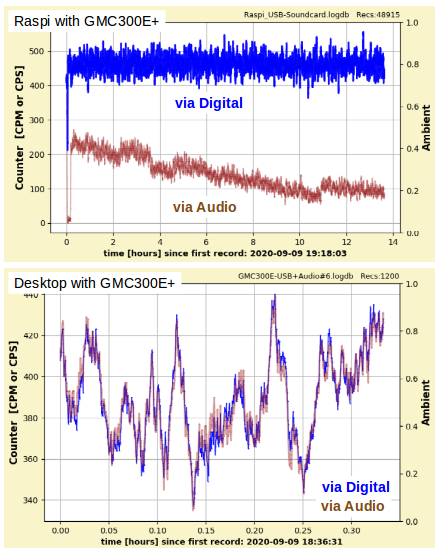
The upper one shows Raspi results: while Raspi easily handles GeigerLog with a digital connection to a GMC counter, it is simply overwhelmed with the audio processing.
The lower pic shows the very same setup, but now connected to my Desktop. One can barely see a load on the CPU. The data are identical within statistical scatter. The main reason for differences is that the time base is not and cannot be synchronized. In this particular example the overall average is Digital-CPM=388.48, while the Audio-CPM=388.45 ;-)) Typically the differences are about 1%.
Conclusion: Raspi is perfectly fine for Digital, but not useful for Audio!
On the Raspi you could use the Audio-clicks as external interrupts, and create a "driver" for Raspi, which counts these interrupts, and then provide some means for Python to get access to those counts - perhaps via a WLAN server running on Raspi -, then the computing burden for Raspi should be low and it very likely will work.
|
 |
|
| Reply #96
Damien68
    
France
780 Posts |
 Posted - 09/10/2020 : 08:57:54 Posted - 09/10/2020 : 08:57:54


|
| I don't know the raspi at all but there must be ways to handle IT with Python and increment register on it. |
Mastery is acquired by studying, with it everything becomes simple |
Edited by - Damien68 on 09/10/2020 23:49:06 |
 |
|
| Reply #97
Damien68
    
France
780 Posts |
 Posted - 09/10/2020 : 23:52:51 Posted - 09/10/2020 : 23:52:51


|
quote:
Originally posted by Damien68
I don't know the raspi at all but there must be ways to handle IT with Python and increment register on it.
Seams to be not easy, discussion about that:
https://www.raspberrypi.org/forums/viewtopic.php?t=9207
EDIT: it would require as ullix says to write some dedicated functions to interface this by his application. what constitutes a full-fledged project, 100 microseconds latency is compatible with the 100 microseconds of tube dead-time.
perhaps the easiest is to buy a GMC-500 + 
if you have an arduino with a SAMD21 microcontroller, it is possible to count the pulses directly with a counter through an event bus line so without even fire ISR routines (zero CPU charge).
But after that you have to transfer the data and process it by the app and it still require some developpements. |
Mastery is acquired by studying, with it everything becomes simple |
Edited by - Damien68 on 09/11/2020 21:24:16 |
 |
|
| Reply #98
ullix
    
Germany
1222 Posts |
 Posted - 10/04/2020 : 00:40:24 Posted - 10/04/2020 : 00:40:24


|
The use of GeigerLog on the 'Raspberry Pi' has been discussed in this thread. See e.g. my own tests in Reply #95. They show that GeigerLog works perfectly fine on Raspi when the counter, in my case a GMC300E+, is connected via the digital, USB-to-Serial connection.
It largely fails when GeigerLog is used in the AudioCounter mode, i.e. when the computer derives a Geiger count from inspecting the audio-clicks generated by the Geiger counter. (As the Raspi has nice audio-output, but no audio-input, you need a USB-Soundcard attached to the Raspi for this.) This is not really surprising given the computing effort needed, for which the Raspi seems to not have enough power.
As a remedy it was suggested to use the audio-click to trigger a hardware interrupt on the Raspi, using its GPIO pins. This would much reduce the required computing power.
This sounded intriguing, and I looked into that. There is actually the module 'RPi.GPIO' available for Raspi, which allows to monitor the GPIO pins for interrupts under control of Python!
However, there is a catch as stated very explicitly by the programmers of the module:
https://pypi.org/project/RPi.GPIO/
quote:
Note that this module is unsuitable for real-time or timing critical applications. This is because you can not predict when Python will be busy garbage collecting. It also runs under the Linux kernel which is not suitable for real time applications - it is multitasking O/S and another process may be given priority over the CPU, causing jitter in your program. If you are after true real-time performance and predictability, buy yourself an Arduino
Linux is not a Real-Time Operating System - and neither is Windows - so you cannot rule out that at certain times a bunch of interrupts occur, but the OS does not register them, as it is busy with other stuff. The result would be an under-estimate of the true count rate. It may not matter much on a powerful system - compare with the near-perfect Desktop results for the AudioCounter in Reply#95 where the Real-Time problems in principle are the same - but on a comparably low power Raspi the situation likely is different.
On an Arduino microprocessor, as mentioned in the quote, which is even less powerful than a Raspi, or on any of the microprocessors used by GQ in the GMC counters, you can exert a lot more control over the interrupts and can handle them up to a count rate higher than what even the fastest Geiger tubes can deliver.
I will not further pursue this, but if anyone takes a shot at it, I am curious about what limits you find!
|
 |
|
| Reply #99
Damien68
    
France
780 Posts |
 Posted - 10/06/2020 : 00:33:33 Posted - 10/06/2020 : 00:33:33


|
I completely agree that neither windows nor linux are designed to be able to count pulses.
with an audio input, for example if we have 2 pulses of 100us separated by 10us , to be sure to sample the 2 pulses plus the space between these 2 pulses it would be necessary to sample every 10us (speed of 100 kHz) this is no realistic.
with a digital input (interuption) there is the interuption respond time which is not guaranteed, firing a script just to increment a register is not very ******y and ask certainly to end or save a context to run another one. we could make a driver in assembly language (machine code) or in c language, but that requires very precise skills but I know that's the kind of thing you can do with windows, certainly also on the raspi.
After that it will still work very correctly with a PC which will buffer the audio samples and will have the computing power to process the data offline, we may miss a few pulses because we will sample at 44.1ksample/s, but this will give a very marginal error. |
Mastery is acquired by studying, with it everything becomes simple |
Edited by - Damien68 on 10/06/2020 07:29:15 |
 |
|
| Reply #100
ullix
    
Germany
1222 Posts |
 Posted - 10/07/2020 : 01:44:03 Posted - 10/07/2020 : 01:44:03


|
@Damien: I disagree. You do not seem to understand the specifc situation.
I have demonstrated often enough, last time even in this thread (see my Reply#95) that you can use an AudioCounter with Linux and with Windows. I have written articles to demonstrate this, see https://sourceforge.net/projects/geigerlog/files/Articles/GeigerLog-AudioCounter-Support-v2.0.pdf/download and see https://sourceforge.net/projects/geigerlog/files/Articles/GeigerLog-Radiation-v1.1%28CAJOE%29-Support-v1.0.pdf/download .
You also do not seem to understand how interrupts would be treated; increment a counting variable upon an interrupt is a rather low-cost operation in terms of computing power. Handling the counts is also not an issue with today's breed of laptops and desktops, powerful enough to do this (as I have demonstrated). The issue comes up only when less powerful systems are running this same operating system.
You are also underestimating the pulse width. See this forum thread http://www.gqelectronicsllc.com/forum/topic.asp?TOPIC_ID=4598, e.g. Reply#10, where i determined the recovery length of a counter pulse are the GMC300E+ with the conclusion:
quote:
Relative to my assessment of the M4011 having a recovery time of 200us, the SBM20 will have 220us, and the SBT11A 250us.
This limits the countrates to CPS=5000, and given the Poisson distribution to something closer to 3000. Then on top of this we have the limit of the Hich-Voltage powersupply, which further limits the countrate, as the voltage simply is collapsing. Also well discussed in this forum.
Then the electronic of a counter will also shape the pulse width, and on a GMC300E+ the audiopulse width is 300 microsecond, adequate when the tube pulse length is 200 us! So here the limit is CPS=3300.
As I am now using a sampling rate of 44100/sec, and a sampling length of 32 samples, the max supported rate is CPS=1400.
All this is well beyond to what most people will experience, except for some who get medical treatment with radioactivity doses, which overwhelm the counters already. For everybody else, the doses to be experiences can be handled perfectly well even with AudioCounters.
|
 |
|
 Topic Topic  |
|

